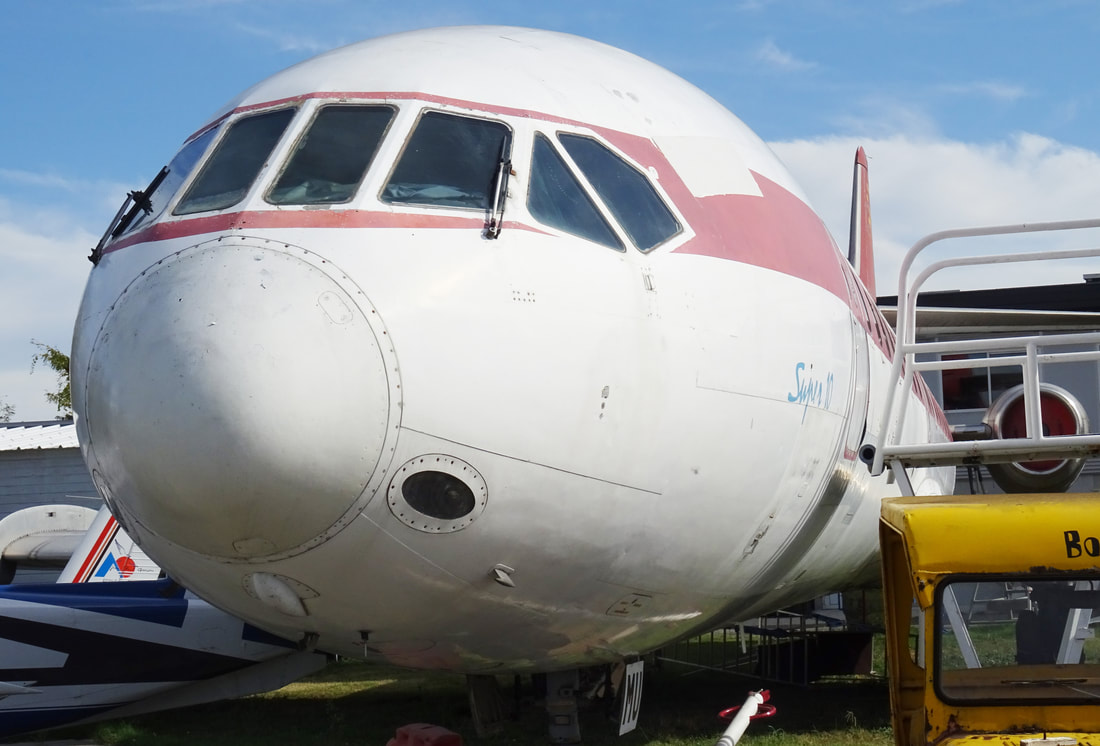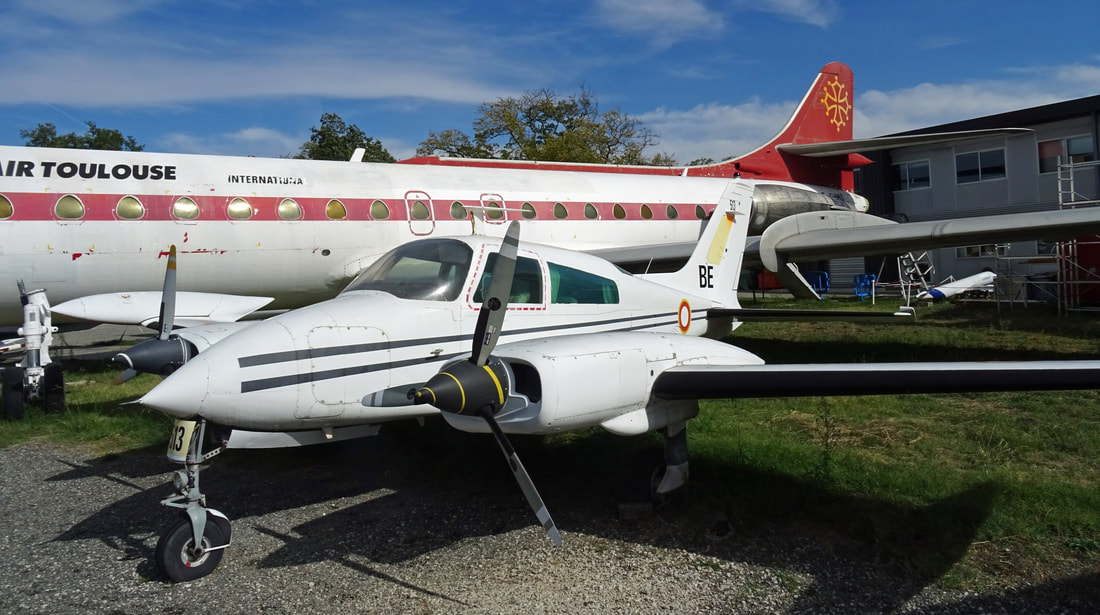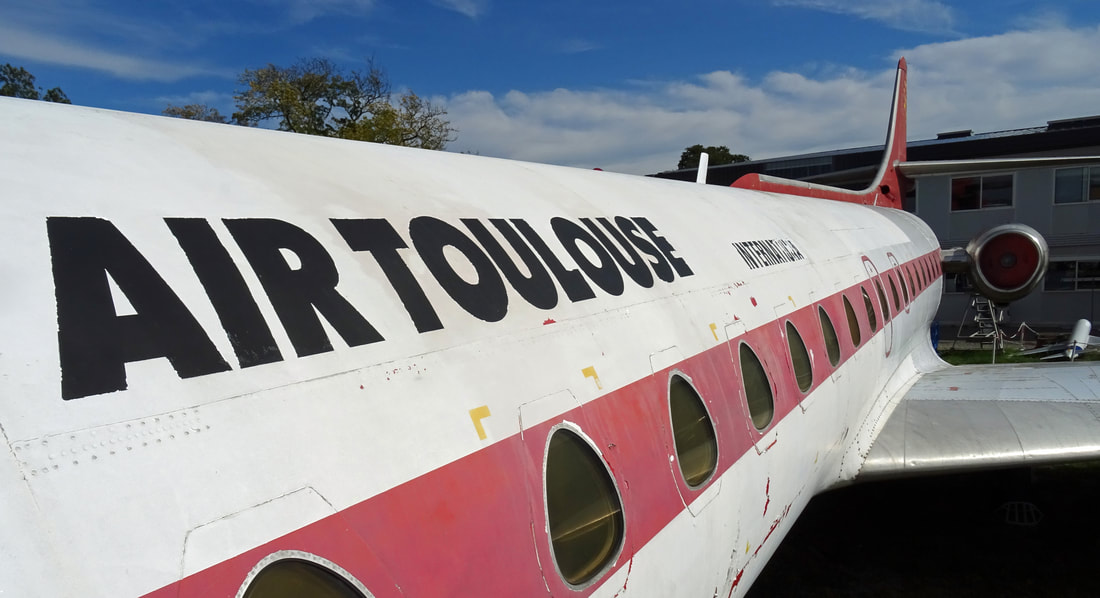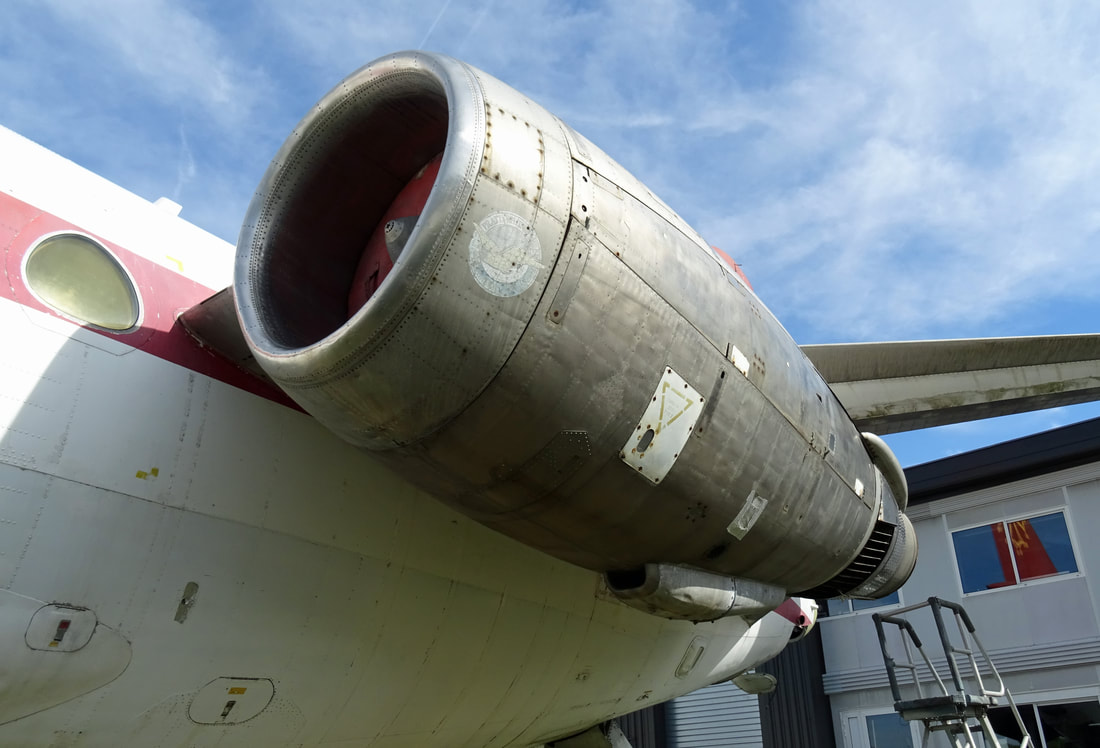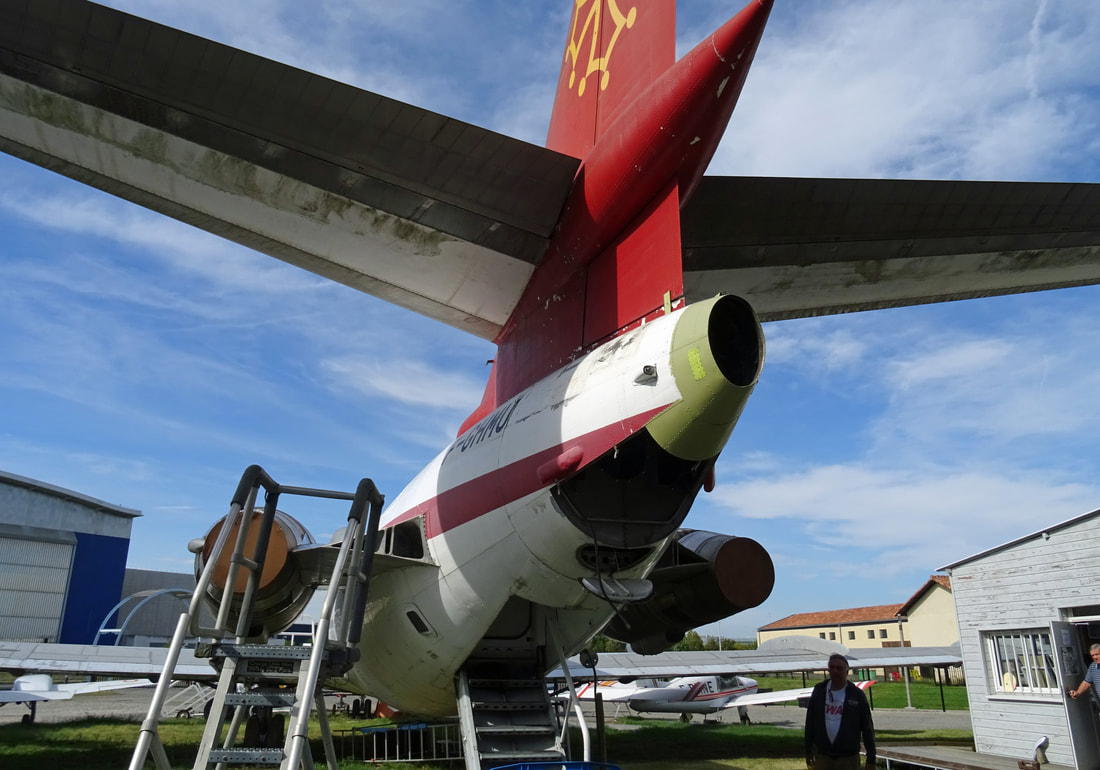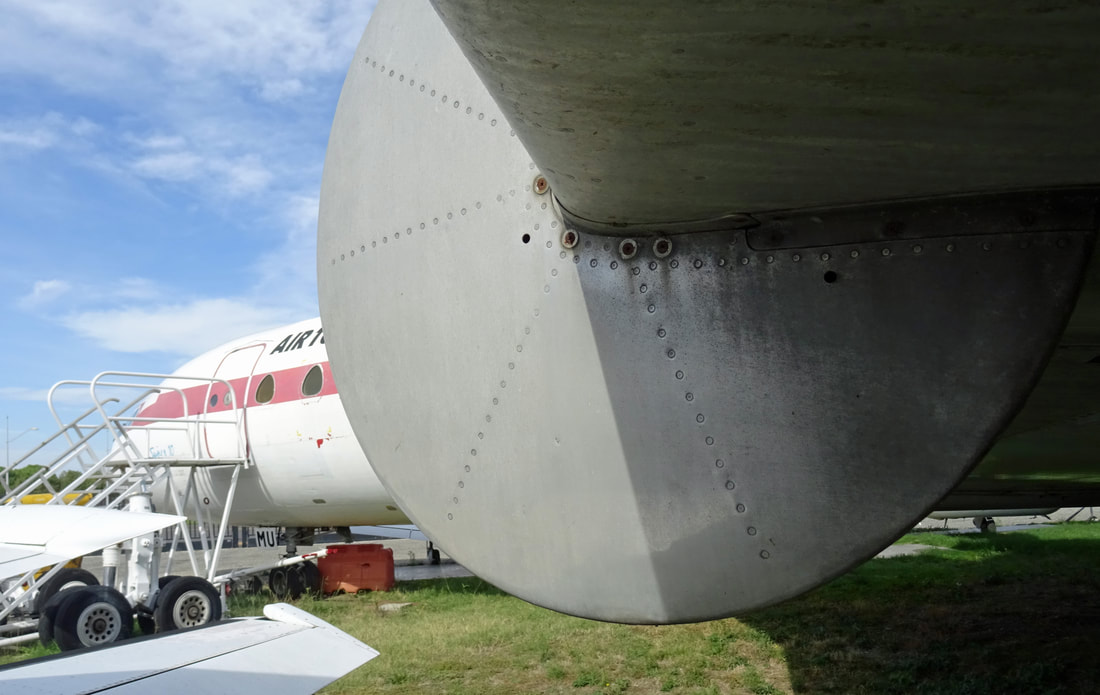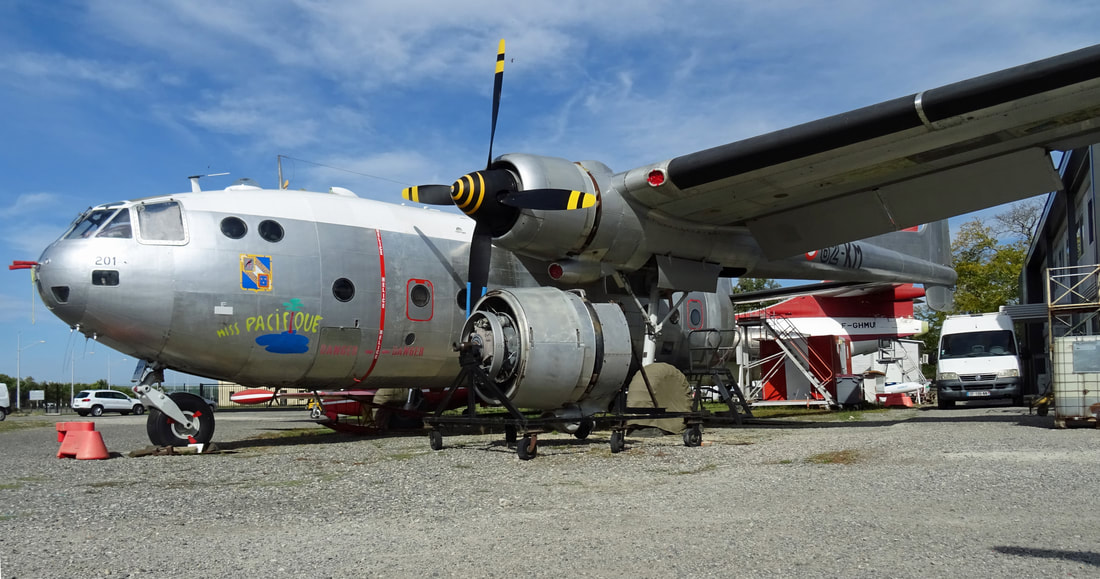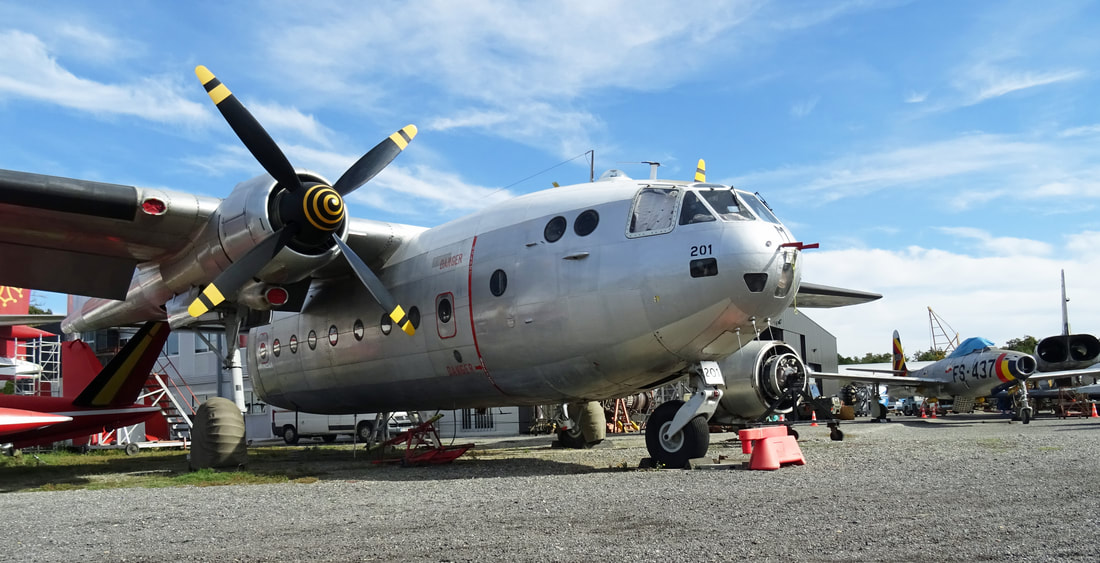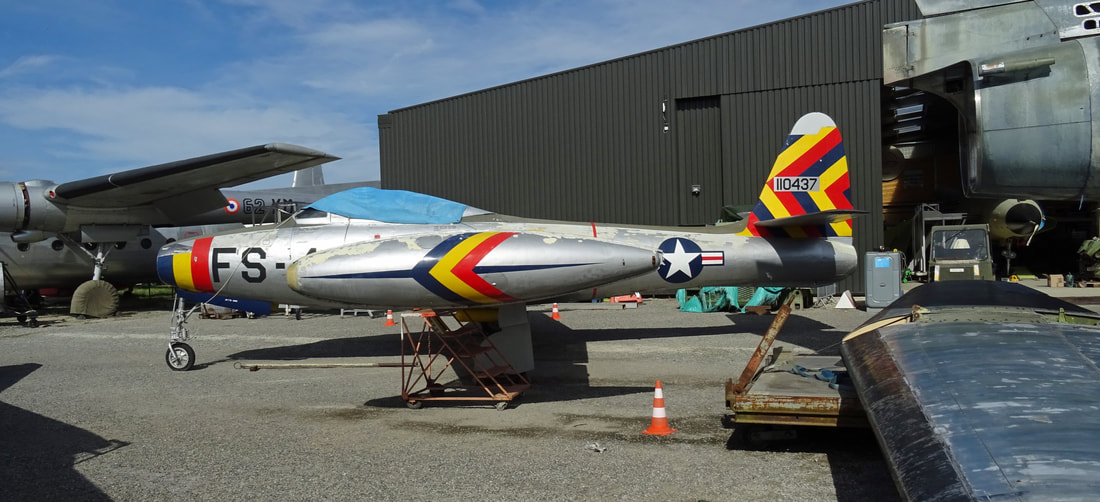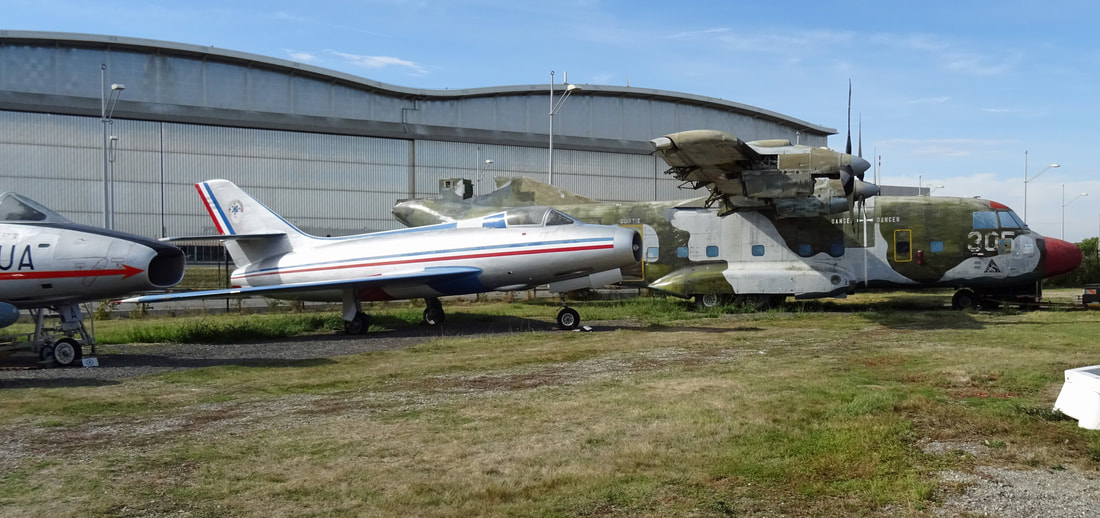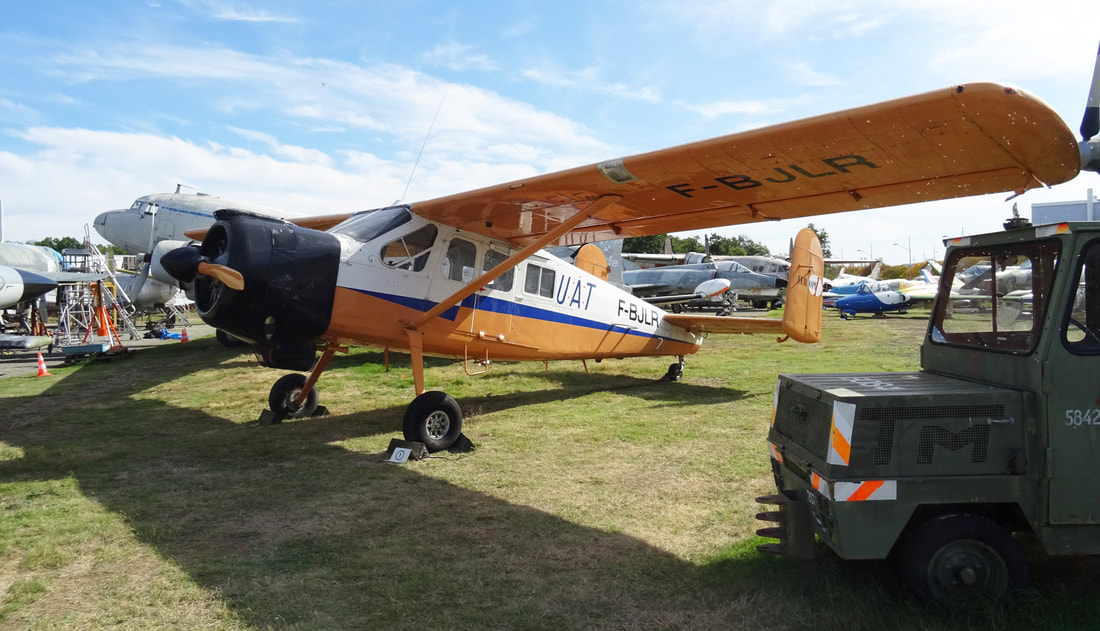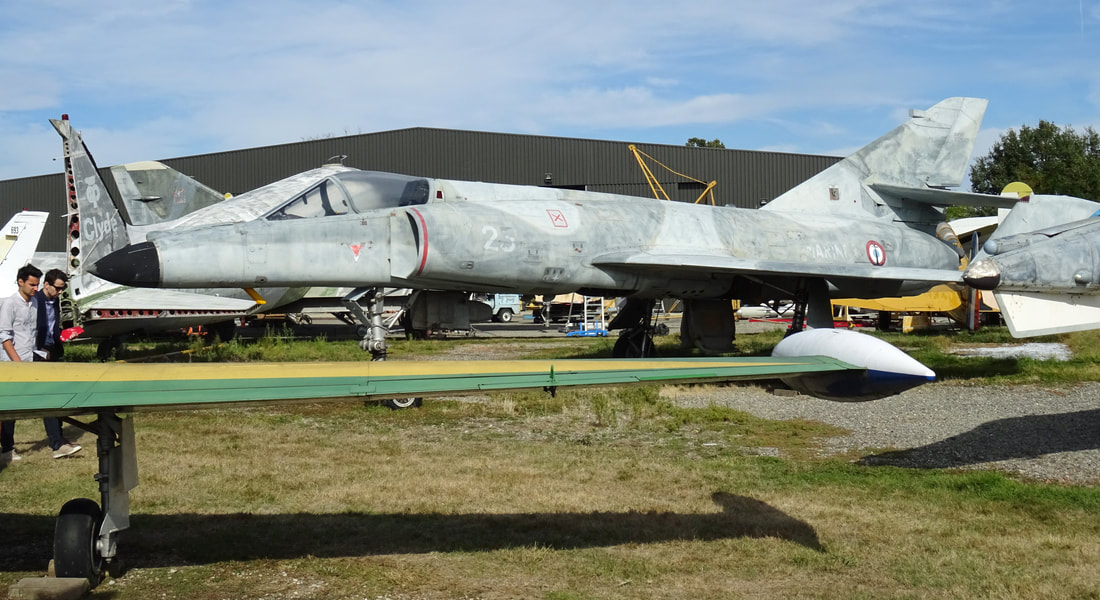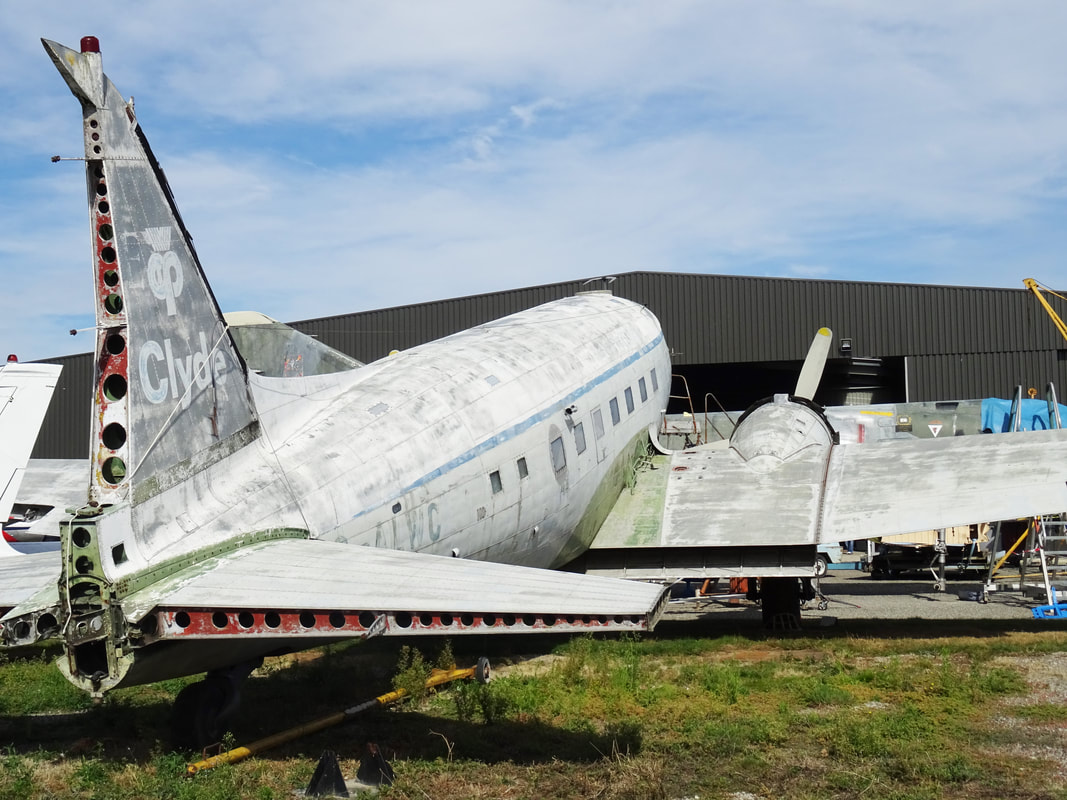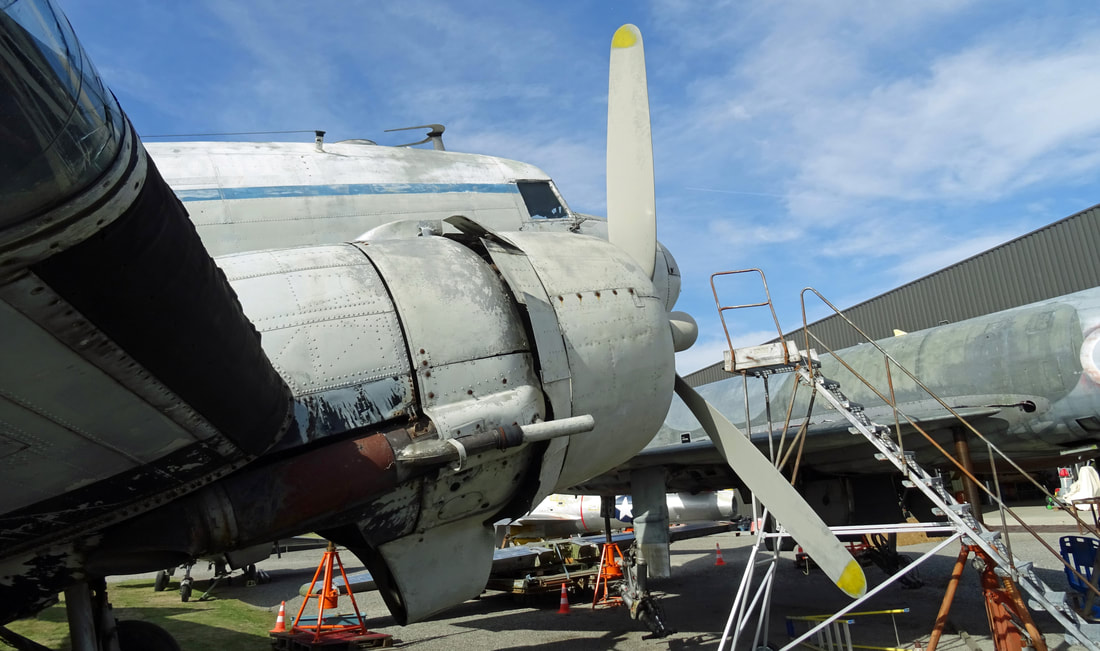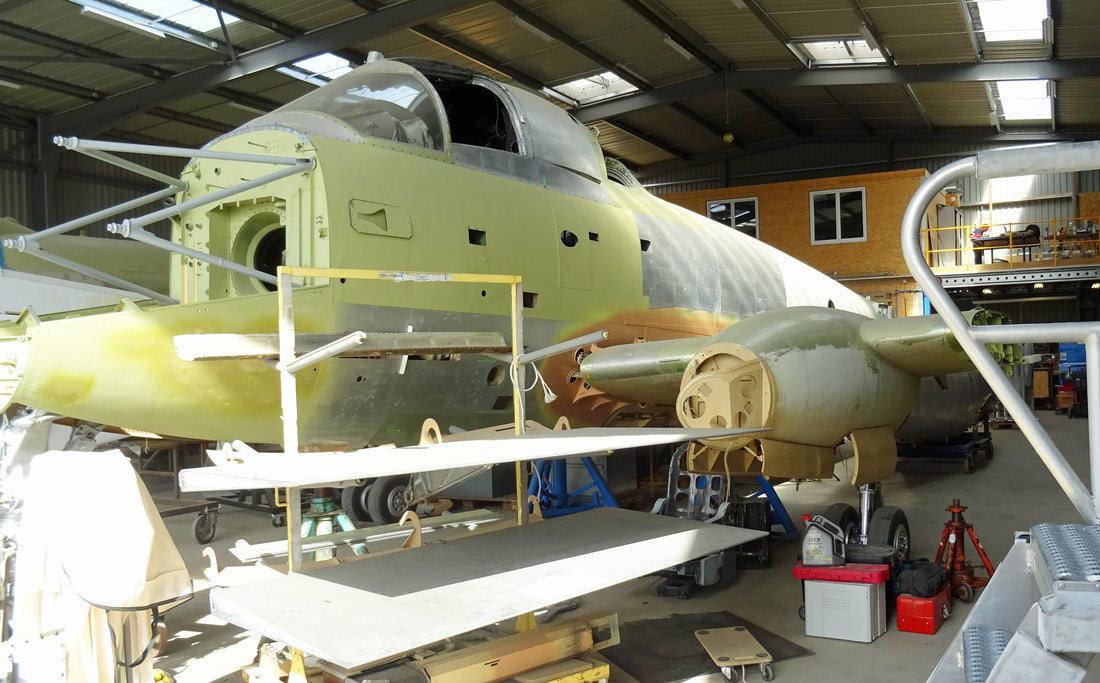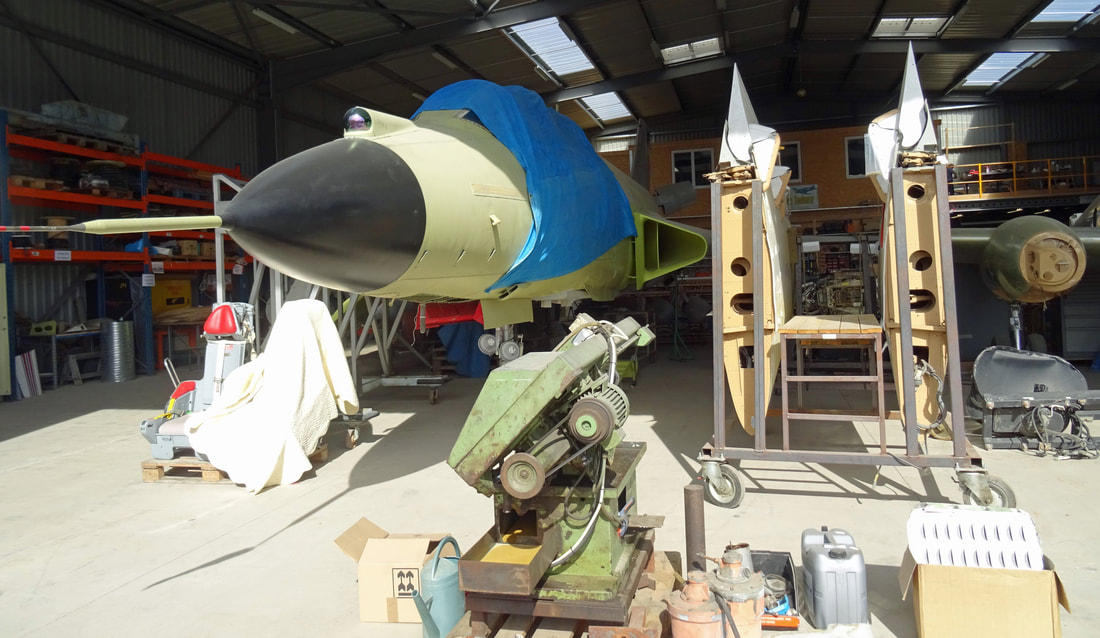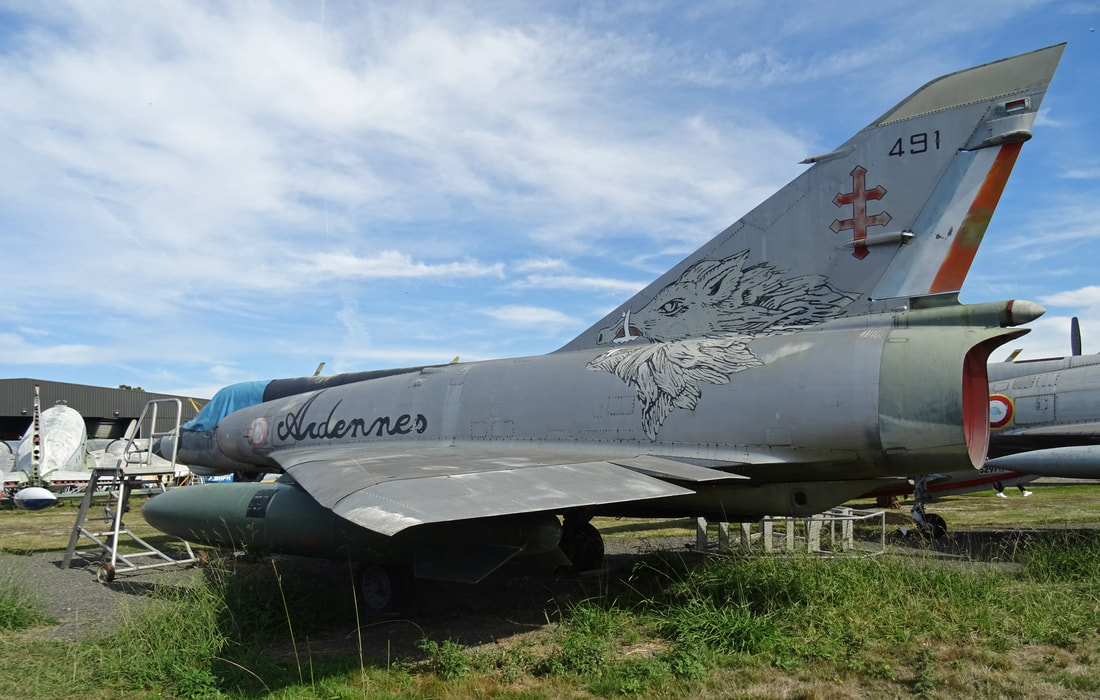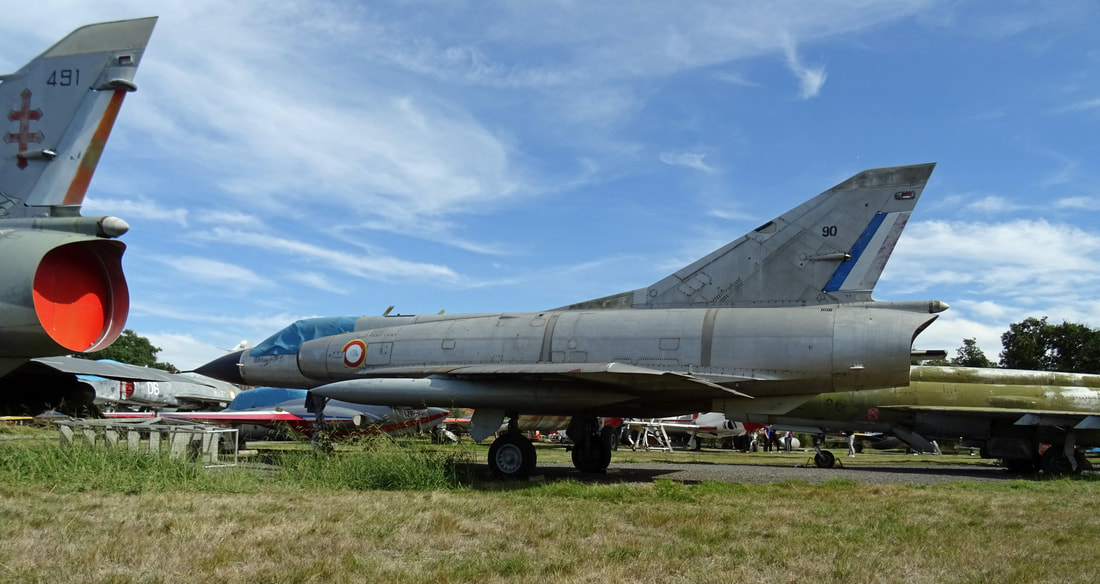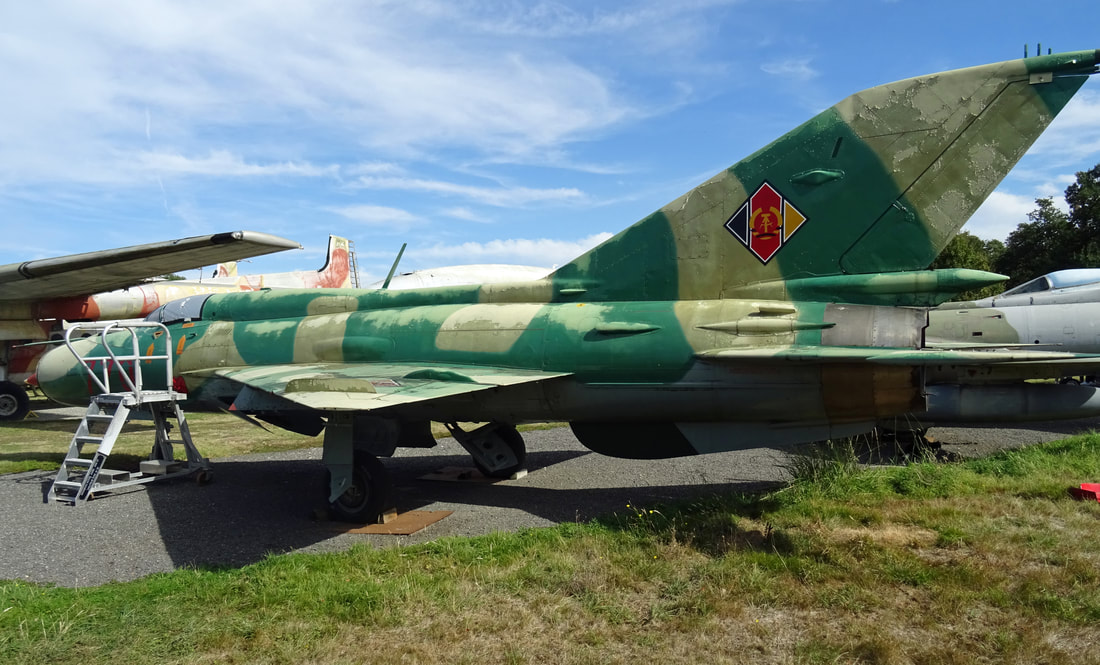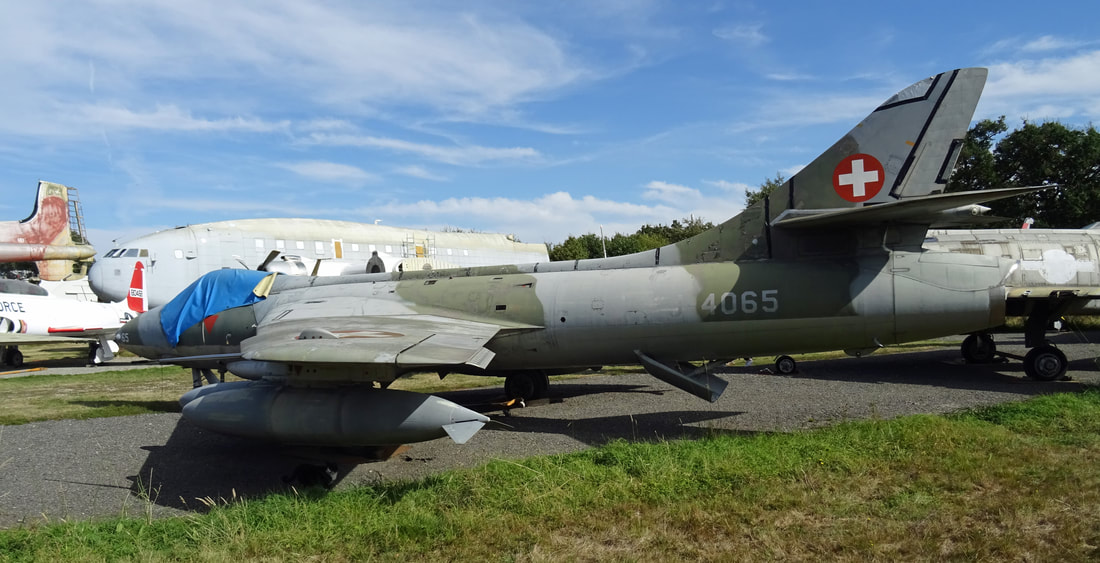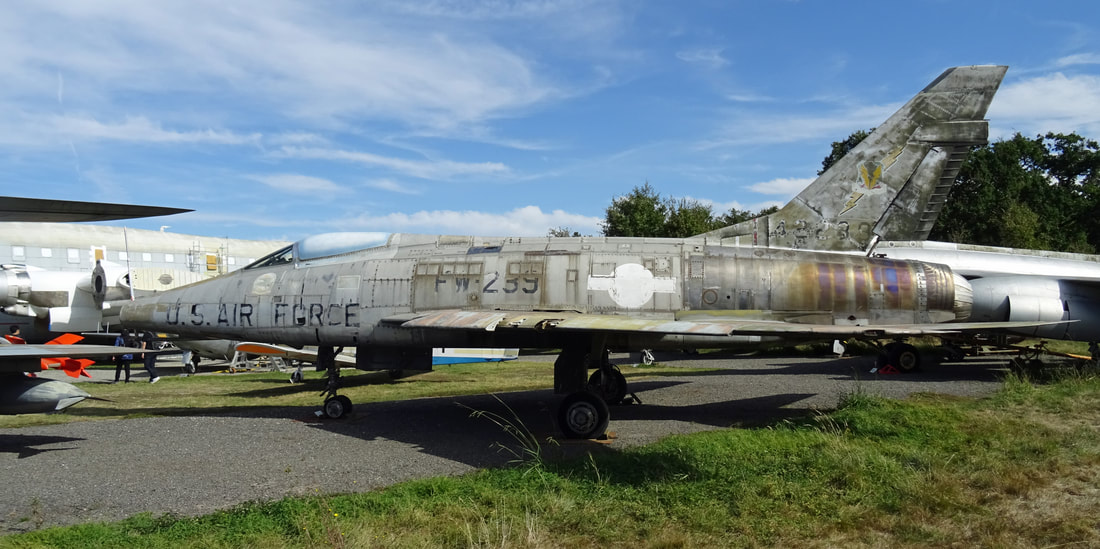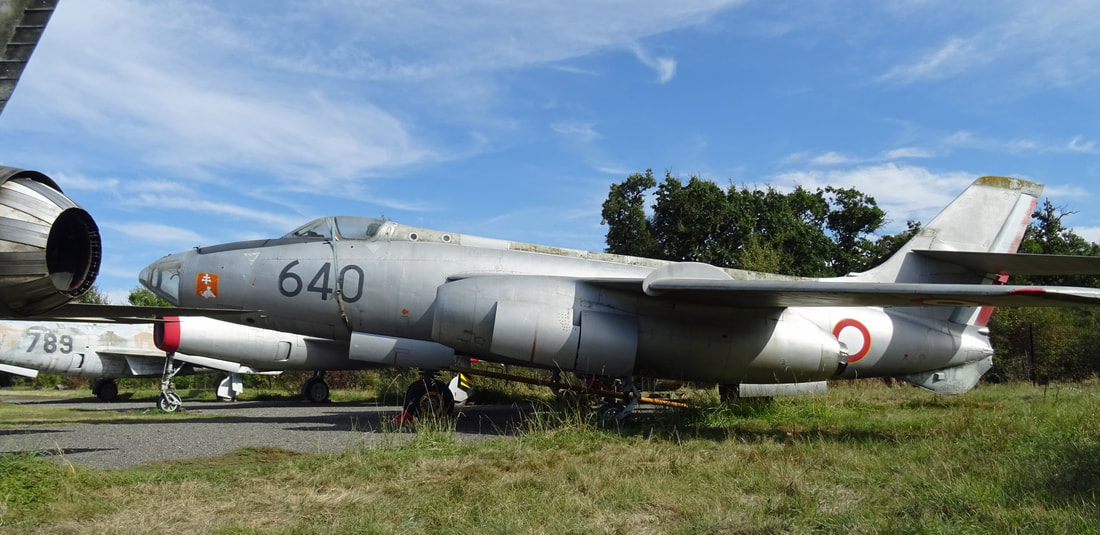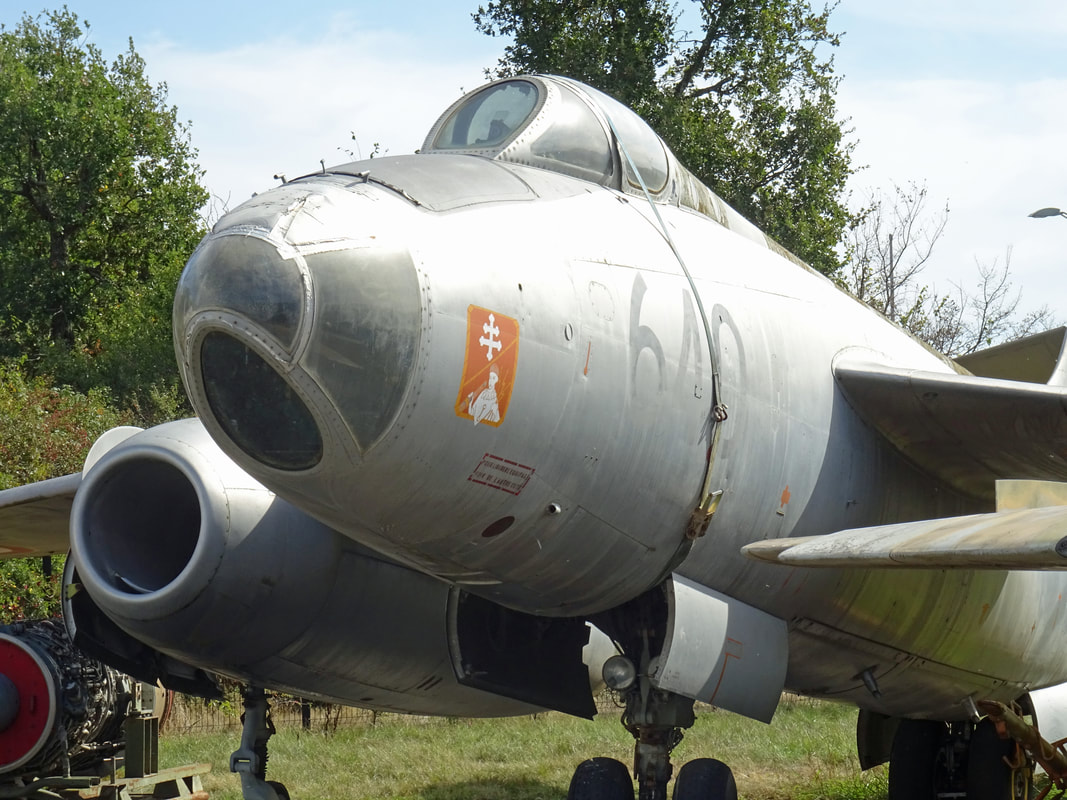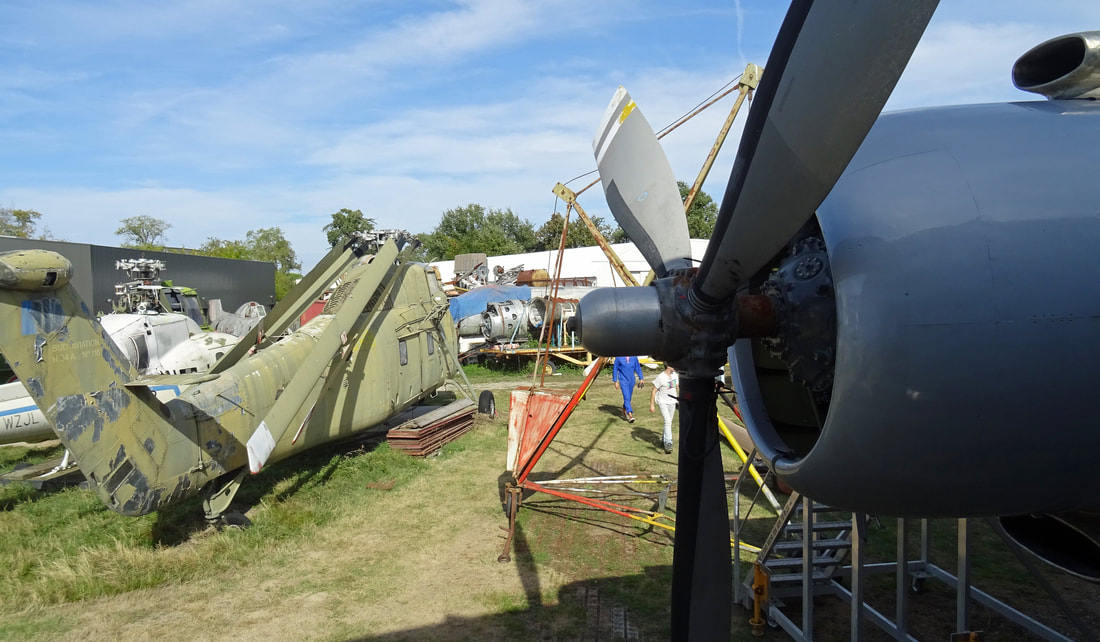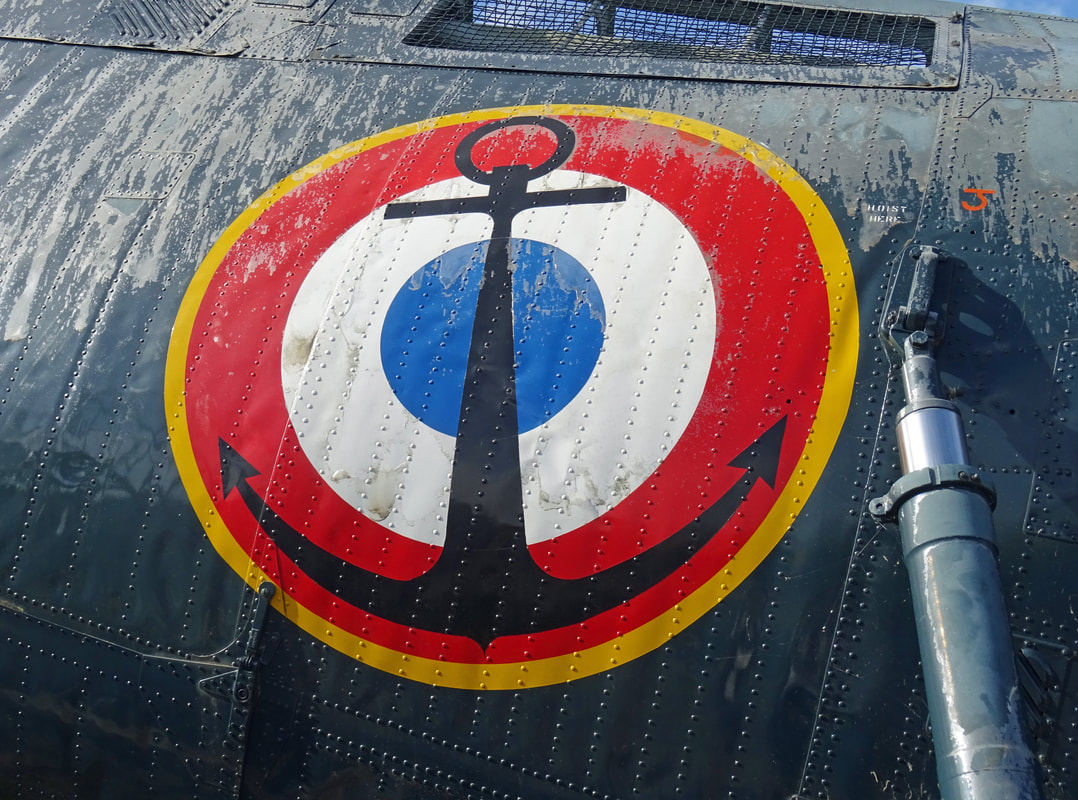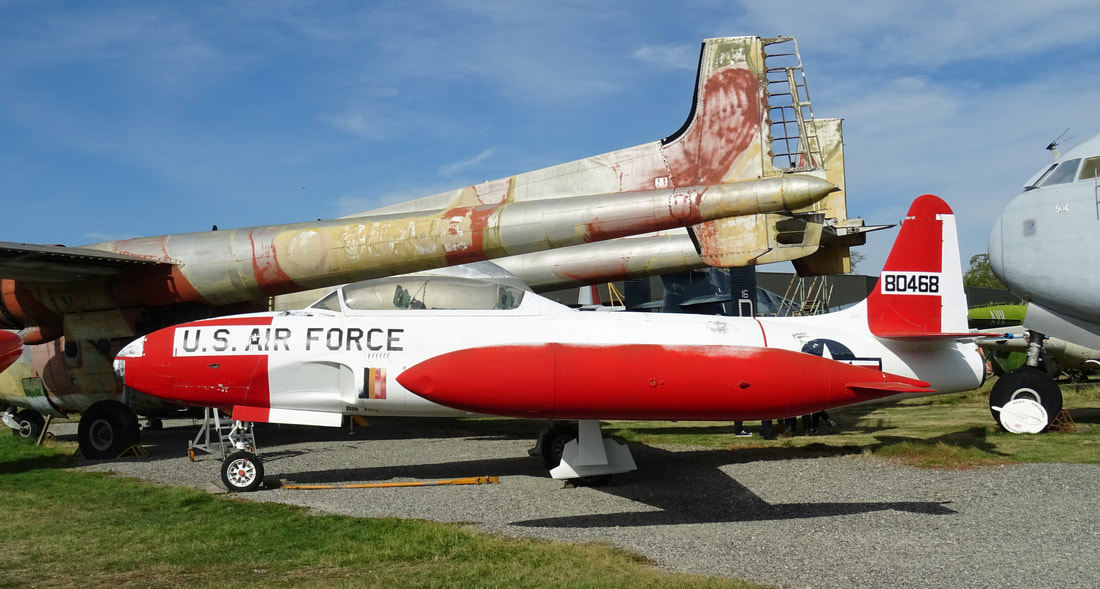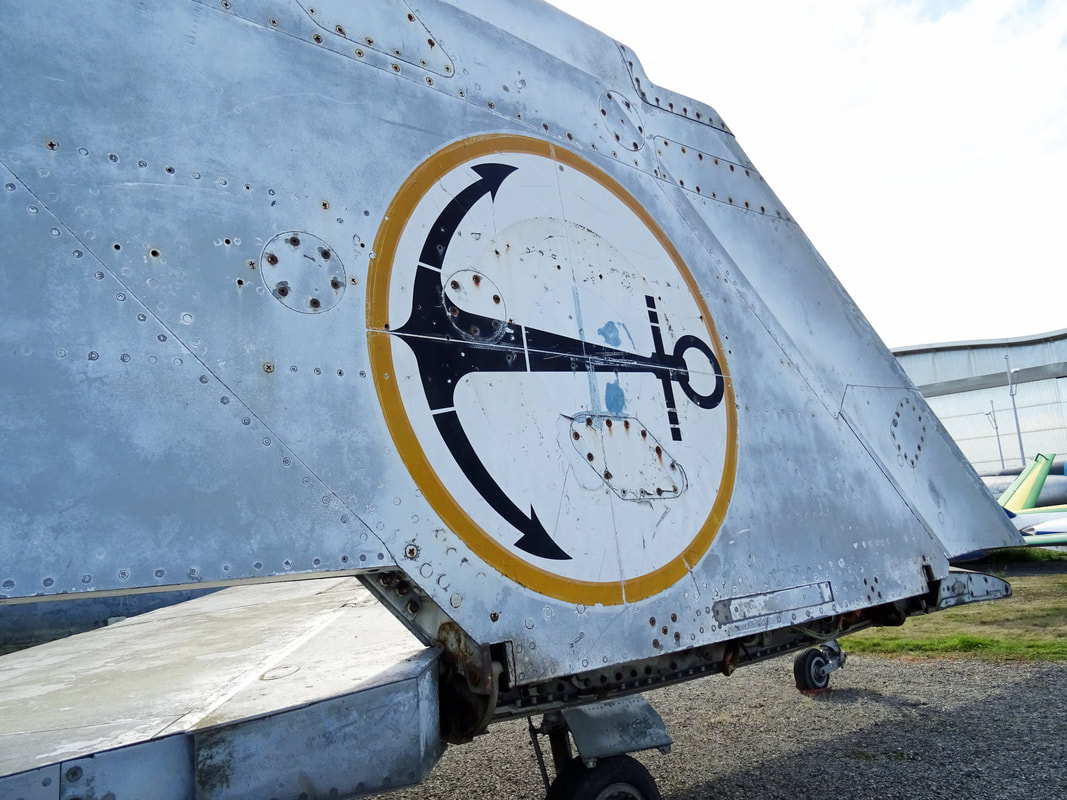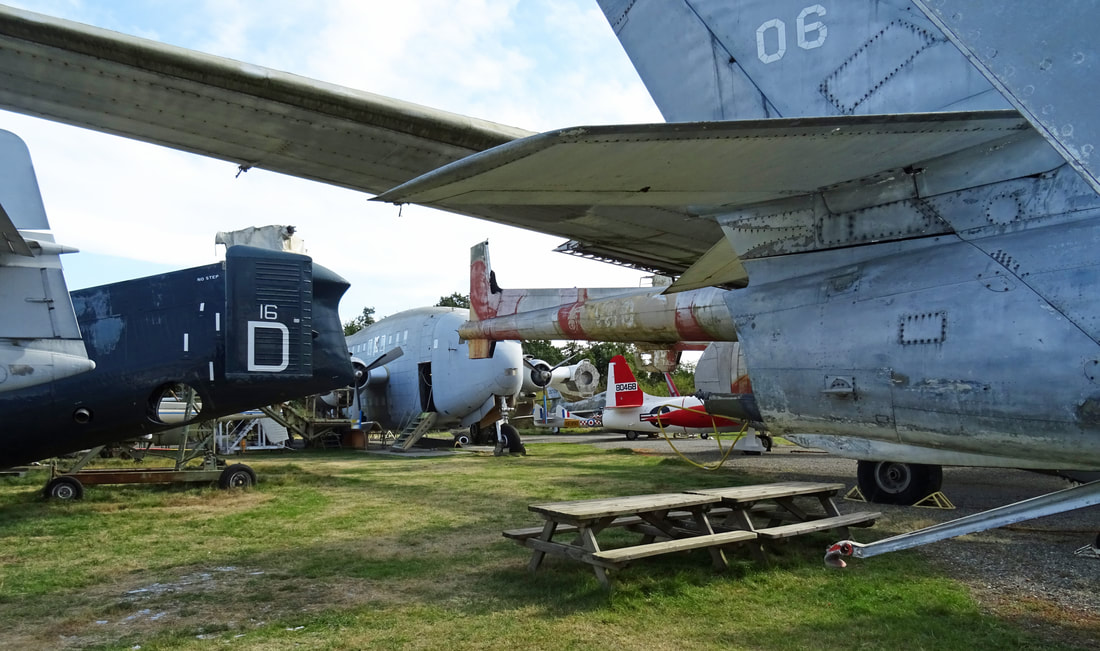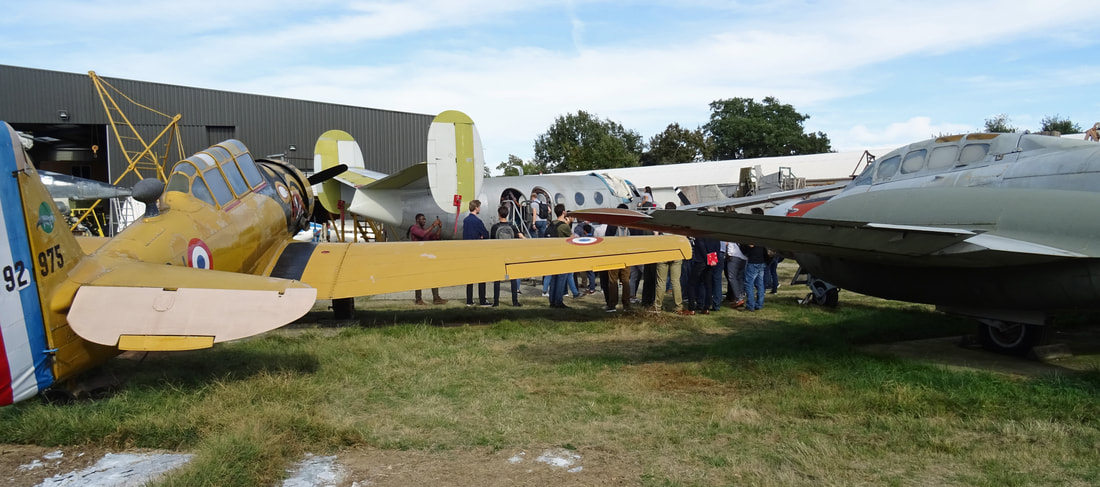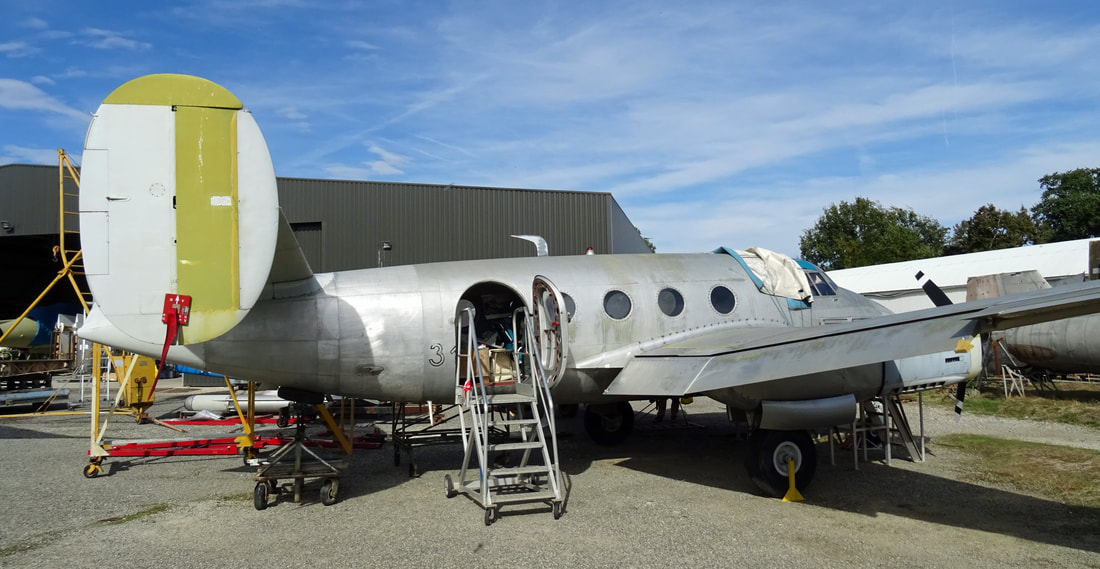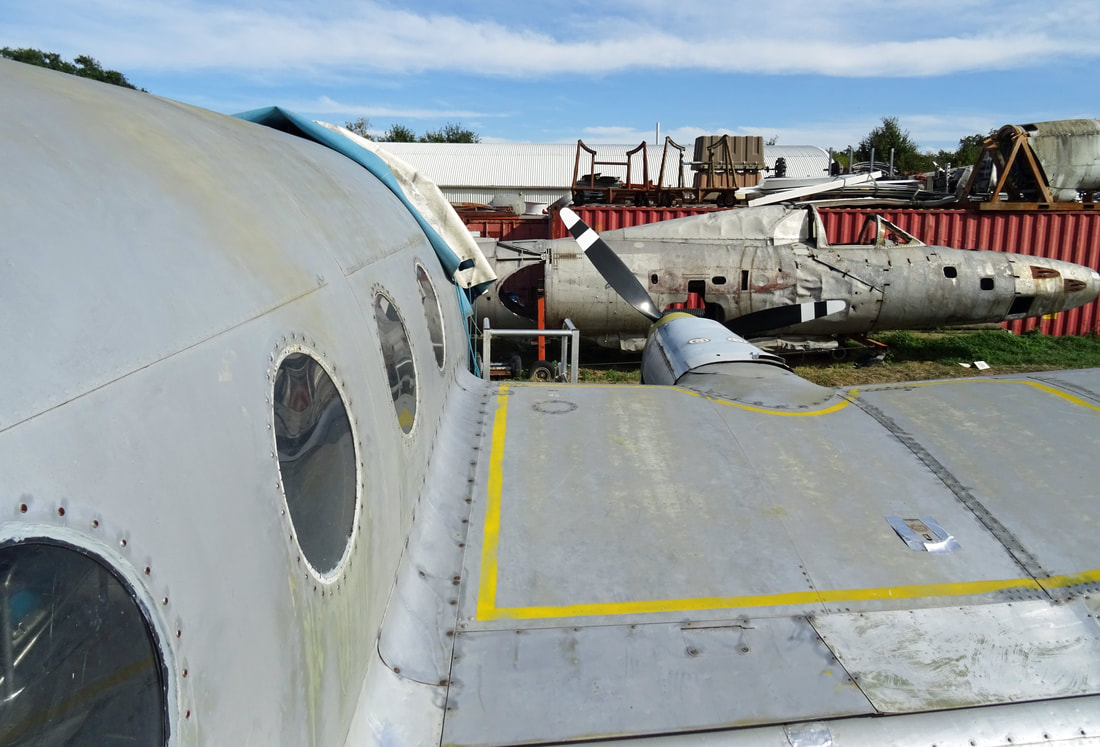Ailes Anciennes Toulouse - Old Wings Toulouse
By Jan Koppen
|
In August 2018, my friend and colleague, Xavier Poirot, and I, as Dutchmen, we wanted to fly the Trade Air's Fokker 100, which flew Toulouse - Rennes - Amsterdam, on behalf of KLM's partner, Air France. While being in Toulouse, we visited the Ailes Anciennes Museum.
|
The Caravelle employed the complete nosesection of the De Havilland Comet 1.
|
|
The preservation of the aeronautical heritage.
Old Wings Toulouse (Ailes Anciennes Toulouse) try to save any aeronautical equipment we find. All this work is intended to place the collection in a shelter in a suitable and visitable space: an Aeronautical Museum in Toulouse (now called Aeroscopia)
Any person of good will and motivation can become a member of the association. No qualification is required (otherwise an immoderate and unexplained passion for air things). Given the various activities and the supervision by the “elders”, one trains by practicing. However, it must be admitted that some tasks such as stripping require only “elbow grease” and patience (and this is part of our regular and indispensable activities). Old Wings Toulouse, only do static restoration. There machines do not fly and will not fly within the current framework of the association. |
Rallye Morane Saulnier MS-881 F-BMNE (c/n. 410) was build in 1969.
|
Socata ST-10 F-WOFN
Air Toulouse International, Sud Aviation SE-210-10 Caravelle, F-GHMU, is seen here resting under a gorgeous summer afternoon sun.
The Caravelle is the result of a 1951 specifi cation by the French Government, calling for a medium transport aircraft capable of carrying 55 to 65 passengers over a distance of 2000km at 600km/h. Sud Aviation won the contract, and the first Caravelle made its maiden fl ight on the 27th of May 1955, powered by Rolls Royce Avon engines. Air France and SAS became the launch customers, the aircraft entering service in 1959. Thanks to several sales tours and displays at air shows, more customers signed up for the aircraft, and an improved version offering a higher Maximum Take-off Weight was introduced.
In order to penetrate the big American market, Sud Aviation joined forces with Douglas and modified the Caravelle to better suit American needs, leading to the Caravelle VI R, 56 of which were built. Later on, Sud Aviation developed a Pratt & Whitney powered version, the Caravelle 10B. The last version of the Caravelle was the Caravelle 12, capable of transporting up to 128 passengers, but with a reduced range. The basic design had clearly reached its limits. Nevertheless, the Caravelle was one of the biggest French commercial aircraft successes, with 282 Caravelles of all versions sold.
In order to penetrate the big American market, Sud Aviation joined forces with Douglas and modified the Caravelle to better suit American needs, leading to the Caravelle VI R, 56 of which were built. Later on, Sud Aviation developed a Pratt & Whitney powered version, the Caravelle 10B. The last version of the Caravelle was the Caravelle 12, capable of transporting up to 128 passengers, but with a reduced range. The basic design had clearly reached its limits. Nevertheless, the Caravelle was one of the biggest French commercial aircraft successes, with 282 Caravelles of all versions sold.
The triangular windows of the Caravelle remained unaltered throughout its development.
The Occitan Cross is sporting majestically on its ventral fin.
The Pratt & Whitney JT8D is a low-bypass turbofan engine, introduced by Pratt & Whitney in February 1963 with the inaugural flight of the Boeing 727. It was a modification of the Pratt & Whitney J52 turbojet engine, which powered the US Navy A-6 Intruder attack aircraft.
|
The front-mounted bypass fan has two stages. The annular discharge duct for the bypass fan runs along the full length of the engine, so that both the fan air and exhaust gases can exit through the same nozzle. This arrangement allows some noise attenuation, in that the still-hot fast-moving turbine exhaust is shrouded in much-cooler and slower-moving air (from the bypass fan) before interacting with ambient air. Thus the JT8D noise levels were significantly reduced from previous non-turbofan engines, although the low bypass ratio meant that, compared to subsequently developed turbofans, high noise levels were still produced.
|
The Caravelle had many innovations aomng which was the airstair for entry via teh rear. There was a door in the rear bulkhead with a tunnel of steffened skin leading downwards.
The adventure began in 1951, when the French authorities entrusted SNCASE with the construction of the first French jet. Associated with the design of the SE 210 (renamed Caravelle, in reference to Christopher Columbus), Air France ordered 12 aircraft in 1956 and integrated it into its fleet in 1959.
The Caravelle became the company's spearhead for Europe and the Mediterranean, and the pride of France during the country's "thirty glorious years" (1945-1975). General de Gaulle made it his presidential aircraft in 1958 and all the great stars travelled on it. On the tarmacs, it was easily recognizable with its ovoid windows, rear engines and retractable stairs. Pilots praised its ‘gentle touch’ and its large wings, making it easier to ensure a kiss landing.
The Caravelle became the company's spearhead for Europe and the Mediterranean, and the pride of France during the country's "thirty glorious years" (1945-1975). General de Gaulle made it his presidential aircraft in 1958 and all the great stars travelled on it. On the tarmacs, it was easily recognizable with its ovoid windows, rear engines and retractable stairs. Pilots praised its ‘gentle touch’ and its large wings, making it easier to ensure a kiss landing.
|
Wing fences, also known as boundary layer fences and potential fences are fixed aerodynamic devices attached to aircraft wings. Often seen on swept-wing aircraft, wing fences are flat plates fixed to the upper surfaces parallel to the airflow, typically wrapping around the leading edge. By obstructing span-wise airflow along the wing, they prevent the entire wing from stalling at once, as opposed to wingtip devices, which increase aerodynamic efficiency by seeking to recover wing vortex energy.
|
|
F-GHMU is a Caravelle 10B-3.
|
The Caravelle 10B-3 is based on the Series 10A. This variant offered many modifications in respect to other series.
It introduced a leading edge extension (a fillet added to the front of an aircraft wings in order to provide usable airflow at high angles of attack). The wing had split flaps instead of the earlier models’ double-slotted Fowler flaps and the fuselage was extended 1.40 m (4 ft 7 in), with an increase in passenger capacity to 105. The engines used were the new Pratt & Whitney JT8D turbofan engines with 6,350 kgf (62,300 N; 14,000 lbf) of unitary thrust. The 10B first flew on August 31, 1964 and was produced as a run of 22 aircraft. |
|
Caravelle F-GHMU, serial number 249, has an interesting history. Originally delivered to Danish charter airline Sterling, it became the personal aircraft of Emperor Bokassa of the Central African Republic in 1975. Five years later, it returned to Europe and was operated by Europe Air Service in France, until sold to Air Toulouse in 1992. It clocked a total flying time of 41,038hrs and 23,000 take-offs and landings.
|
|
The Occitan cross (also called cross of Toulouse; is a heraldic cross, today chiefly used as a symbol of Occitania.
The design was probably first used in the coat of arms of the counts of Forcalquier (in modern Provence), in the 12th century, and by the counts of Toulouse in their capacity as Marquises of Provence, on 13th century coins and seals. A yellow Occitan cross on a blood-red background with the seven-armed golden star of the Felibritge makes up the flag of modern-day Occitania. It can also be found in the emblems of Midi-Pyrénées, Languedoc-Roussillon and Hautes-Alpes, among many others, as well as in cemeteries and at country crossroads. Wherever you go in the Languedoc, you will notice the Cross of Toulouse. You will find it incorporated into official arms of local government bodies, embroidered on flags, carved in stone, wrought in iron, printed on postcards, displayed in stained glass. You will find it worn as jewelry, sold as souvenirs to tourists, scrawled on walls as graffiti. You will even find it on SE-210 Caravelle’s! |
Beautiful and elegant, The Caravelle!
The Caravelle 10A and 10B, differed not only in the engines used and were commonly referred to as the Super Caravelle, featured the improvements of the VI-R in addition to a high degree of further design changes. The more high-profile modifications included a stretch of the fuselage by 33 inches (84 cm); a highly altered wing; an aerodynamic fairing behind the fin of the tail plane; expanded cargo capacity via raised floor support struts; and higher cabin windows. Other changes included the adoption of variable-displacement pumps for the hydraulic system and the use of AC-based generators in place of earlier DC counterparts along with an auxiliary power unit (APU). The redesigned wing was equipped with double-slotted Fowler flaps, additional and repositioned stall vanes, aerodynamic improvements to the wing root and adjustments to the leading edge that improved the performance of the wing during the crucial takeoff and landing phases of flight.
The dorsal ridge housed avionics and HF antennas. This is a non-metallic radome. It protects the antenna from aerodynamic effects, and from water and ice which damage antenna electromagnetic characteristics. The HF antenna was required when using long range HF navigation (Loran) and HF communications, typically over oceans and large non populated areas.
The dorsal ridge housed avionics and HF antennas. This is a non-metallic radome. It protects the antenna from aerodynamic effects, and from water and ice which damage antenna electromagnetic characteristics. The HF antenna was required when using long range HF navigation (Loran) and HF communications, typically over oceans and large non populated areas.
Belgium Air Force Fouga CM-170 Magister, serial '208'.
Fouga Magister, serial number 208, is from the Saint-Etienne aerodrome in February 2014. It was then sent to the painting training centre IFI Peinture which apply a new 'Red Devils' livery.
Noratlas N2501, serial '201/M', named Miss Pacifique, is seen here gleaming on Ailes Anciennes gravel apron in August, 2018.
This Noratlas had been based for several years at Toulouse-Blagnac airport, owned by a private collector. It joined the museum's collection in 2003.
'201/M' is a particularly handsome example and is seen here warming its natural metal finish in the strong French sunshine.
|
The Nord 2501 Noratlas was developed in the late 1940s as a replacement of the Douglas DC3 (which you can see alongside) and the Junkers Ju 52/3m, the transport aircraft then in service with the French Air Force. These aircraft offered only a limited payload and suffered from being taildraggers with lateral freight doors, which made loading/unloading on the ground rather impractical. The Noratlas emerged as the winner of a call for tender launched by the French general staff to remedy these problems.
|
After its maiden flight on the 10th of September 1949, the Bristol-Hercules powered machine saw service in virtually all French territories and
many confl icts, including Indochina, the African colonies and the Suez Crisis. Its tasks consisted of carrying cargo and passengers, but also dropping paratroopers and electronic intelligence gathering. It served with distinction in the French Air Force from 1953 until its retirement in 1989.
many confl icts, including Indochina, the African colonies and the Suez Crisis. Its tasks consisted of carrying cargo and passengers, but also dropping paratroopers and electronic intelligence gathering. It served with distinction in the French Air Force from 1953 until its retirement in 1989.
Nord manufactured 420 aircraft, of which 208 were used by the French Air Force, while export customers including Israel, Portugal and Germany.
Republic F-84G Thunderjet, serial '110437/FS'.
The F-84G is a close relative and the predecessor of the F-84F that can also be seen in our collection. It is a first-generation jet fighter with straight wings, largely similar to Second World War piston-engined fighters. The first prototype made its maiden flight on the 18th of February 1946.
The aircraft was deemed stable and reliable by its pilots, but the first combat experiences in the Korean War also revealed that it was no match for more modern fighters such as the Soviet MiG- 15. It was relegated to ground attack missions in which it performed satisfactorily. The last F-84Gs were used by the Portuguese in Mozambique and Angola until 1975.
France took delivery of 316 F-84Gs in 1951 that equipped up to 15 squadrons, including the famous Patrouille de France aerobatics team. They were serviced by SNCASE at Toulouse, one of the predecessors of Airbus, and finally replaced in 1957 by F-84Fs.
The aircraft was deemed stable and reliable by its pilots, but the first combat experiences in the Korean War also revealed that it was no match for more modern fighters such as the Soviet MiG- 15. It was relegated to ground attack missions in which it performed satisfactorily. The last F-84Gs were used by the Portuguese in Mozambique and Angola until 1975.
France took delivery of 316 F-84Gs in 1951 that equipped up to 15 squadrons, including the famous Patrouille de France aerobatics team. They were serviced by SNCASE at Toulouse, one of the predecessors of Airbus, and finally replaced in 1957 by F-84Fs.
The displayed aircraft is a composite airframe. We received the fuselage from the air base at Bourges in 1982, and recovered the wings from the fi ring range at Cazaux the same year. The restoration of the aircraft (often rather a reconstruction) is the most complex restoration ever undertaken by the Ailes Anciennes until now and took more than 20 years.
A Super Mystere B2, a mystere IVA and Breguet BR.941S keeping the French flag high!
Tail clipped Breguet BR.941S, serial '305'.
In the mid-1950s, Breguet Aviation began studying a blown-wings system where lift would be increased at slow speeds thanks to the propellers’ airflow, effectively creating Short Take-Off and Landing (STOL) aircraft. A flying testbed was built, fitted with triple-slotted fl aps extending up to 97° and powered by four, 400shp Turbomeca Turmo II turbines, driving 4-meter Ratier propellers. At the same time, a similar aircraft was built in Villacoublay for flight test purposes. Named Br.940 «Integral», the plane first flew on May 21st, 1958.
For increased safety, all four propellers were driven by a common shaft. In case of an engine failure, all propellers would thus keep spinning. The Br.940 made a strong first impression in the 1959 Paris Airshow, where its impressive STOL performance was showcased.
In early 1960, Breguet received an order for a prototype to carry 47 passengers or a 7-tonne freight payload. The to-be Br.941 was built in
Toulouse-Colomiers.
Its maiden flight took place on June 1st, 1961. This aircraft’s outstanding performance resulted in a cooperation agreement being signed with McDonnell Aircraft. In June 1964, the rebranded McDonnell 188 ran an US tour to convince armed forces how useful such an aircraft would be. Near the end of this tour, the plane was heavily damaged after a hard landing, grounding it for 8 months.
The aircraft in the picture is Breguet 941S nr.3. After its military career, it was showcased in a theme park in Ardèche, before joining our collection in early 2015.
For increased safety, all four propellers were driven by a common shaft. In case of an engine failure, all propellers would thus keep spinning. The Br.940 made a strong first impression in the 1959 Paris Airshow, where its impressive STOL performance was showcased.
In early 1960, Breguet received an order for a prototype to carry 47 passengers or a 7-tonne freight payload. The to-be Br.941 was built in
Toulouse-Colomiers.
Its maiden flight took place on June 1st, 1961. This aircraft’s outstanding performance resulted in a cooperation agreement being signed with McDonnell Aircraft. In June 1964, the rebranded McDonnell 188 ran an US tour to convince armed forces how useful such an aircraft would be. Near the end of this tour, the plane was heavily damaged after a hard landing, grounding it for 8 months.
The aircraft in the picture is Breguet 941S nr.3. After its military career, it was showcased in a theme park in Ardèche, before joining our collection in early 2015.
Dassault Mystere IVA '44'
The Dassault Mystère IVA was developed at the same time as the Hawker Hunter and was used in the same role as its British counterpart.
The prototype made its maiden fl ight on the 28th of September 1952 and was followed by 411 serial aircraft. After serving in the air defence role for some years, the Mystère IVAs were modifi ed for ground attack duties from the early 1960s.
The aircraft had a very good reputation among pilots as it was easy to handle and allowed precise
flying. This made it an ideal aerobatics aircraft, so it was chosen to equip the Patrouille de France aerobatic team from 1957-1963. Other aircraft were used as air combat trainers and remained in service until 1982.
France exported the Mystère IVA to Israel and India where the type saw combat in several conflicts.
Our Mystère IVA, serial number 44, arrived in 1983 from Cazaux. However, it actually belongs to the US Air Force Museum (in an effort to support its allies, the United States had fi nanced roughly half of the Mystère IVA production in the 1950s). It is displayed in a Patrouille de France paint scheme, representing the aircraft flown by Capitaine Larrayadieu.
The prototype made its maiden fl ight on the 28th of September 1952 and was followed by 411 serial aircraft. After serving in the air defence role for some years, the Mystère IVAs were modifi ed for ground attack duties from the early 1960s.
The aircraft had a very good reputation among pilots as it was easy to handle and allowed precise
flying. This made it an ideal aerobatics aircraft, so it was chosen to equip the Patrouille de France aerobatic team from 1957-1963. Other aircraft were used as air combat trainers and remained in service until 1982.
France exported the Mystère IVA to Israel and India where the type saw combat in several conflicts.
Our Mystère IVA, serial number 44, arrived in 1983 from Cazaux. However, it actually belongs to the US Air Force Museum (in an effort to support its allies, the United States had fi nanced roughly half of the Mystère IVA production in the 1950s). It is displayed in a Patrouille de France paint scheme, representing the aircraft flown by Capitaine Larrayadieu.
Dassault Super Mystere B2, serial '48/12UA'.
The displayed aircraft, serial number 48, was transported by road to Toulouse. It had previously been displayed at the air base at Rochefort. It was restored it in the 1990’s.
The Super Mystère B2 was a stop-gap aircraft, supposed to fill the gap between the subsonic Mystère IVA and the entry into service of the Mach- 2-capable Mirage III.
The first prototype made its maiden flight on the 2nd of March 1955. Originally, it was planned to build 370 serial aircraft, but the order was rapidly reduced to only 180 due to budgetary limitations and the arrival of the Mirage III.
Nevertheless, the Super Mystère B2 made history by becoming the first European production aircraft capable of reaching Mach 1 in level flight. Despite its shortcomings such as difficult handling qualities and being underpowered when the afterburner was not used, it gave the French Air Force pilots the possibility to gain valuable experience in supersonic flight, preparing them for the Mirage III.
The first prototype made its maiden flight on the 2nd of March 1955. Originally, it was planned to build 370 serial aircraft, but the order was rapidly reduced to only 180 due to budgetary limitations and the arrival of the Mirage III.
Nevertheless, the Super Mystère B2 made history by becoming the first European production aircraft capable of reaching Mach 1 in level flight. Despite its shortcomings such as difficult handling qualities and being underpowered when the afterburner was not used, it gave the French Air Force pilots the possibility to gain valuable experience in supersonic flight, preparing them for the Mirage III.
|
Cessna 310, serial 693/BI.
The Cessna 310 was one of the most popular private aircraft. The first prototype made its maiden flight on the 3rd of January 1953 and was to be followed by 6.321 production aircraft, the last rolling off the production line in 1980. The six-seater was Cessna’s first twin-engined aircraft after World War Two, immediately becoming a big success.
Hundreds of Cessna 310s of various subtypes are still in service and popular as air taxis and private aircraft. Many have been modifi ed for various roles, ranging from forest fi re detection to bush aircraft. The type also saw military use as liaison aircraft. |
The displayed aircraft has the serial number 310- 693 and was used by the French “Centre d’Essais en Vol” (French Flight Test Centre). It was handed over to the Ailes Anciennes by the Direction Générale pour l’Armement (General Directorate for Armament) in 2009.
|
Max Holste Broussard F-BJLR with fake UAT titles.
The Broussard, first flew on the 17th of December 1952, is a true general purpose aircraft. Capable of carrying up to 6 passengers, it was used in a variety of roles by the French Air Force and Army: Flying command post, liaison duties, medical evacuation, paratrooper training… its ruggedness and its capability of taking off from short, improvised landing grounds made it a very popular aircraft especially during the Algerian War, albeit its two bladed propeller also made it very noisy, warning enemy troops of its proximity and thereby limiting its value as an observation aircraft. Even the fitting of a three-bladed propeller could not completely solve this problem.
|
The main user of the aircraft was the French Air Force and Army, but it was also popular among civil operators. A number of Broussards were handed over to the armed forces of former French colonies after their independence (Togo, Burkina- Faso).
Max Holste produced 356 Broussards, the last of which were retired from the French Army Air Service only in 1992. Nevertheless, many Broussards were used by civilian operators and flying clubs, and numerous aircraft are still in airworthy condition in France and abroad. |
This Broussard is recovered in 1982 from Montauban and transported it by road to Toulouse. Completely restored to static condition in the 1990s, it is currently exhibited in the colors of an aircraft operated by the radio station “Europe 1” during Tour de France bicycle races.
Saab J-350E Draken, serial '02', looks to be in superb condition.
The first studies for the Saab J35 Draken (Dragon) date back to 1949 when Sweden first thought about a future replacement for its first-generation jet fighter Saab J29 Tunnan. The Draken’s first prototype made its maiden flight in 1955, and the type was introduced in service with the Royal Swedish Air Force in 1960. An improved version named J35D and equipped with improved avionics and a new engine allowing the Draken to attain Mach 2 is introduced in 1963.
When Austria, which had been a neutral country during the Cold War, looked for a new jet fighter in the early 1980s, it chose to buy used J35Ds in Sweden, a neutral country, too.
After further upgrades including a self-defence system, the type entered service with the Austria air force in 1985 as J35OE (or J35Ö for Österreich/Austria). Austria finally retired its Drakens in 2005. They have been replaced by F-5’s.
After further upgrades including a self-defence system, the type entered service with the Austria air force in 1985 as J35OE (or J35Ö for Österreich/Austria). Austria finally retired its Drakens in 2005. They have been replaced by F-5’s.
Fouga Magister '457' is a former Brazil Air Force jet trainer taken from the cockpit of Magister '178' Armee de l'Air.
Magister, serial number 457, arrived by road in 2008 from the nearby Toulouse-Francazal air base. It was repainted by Blagnac-based STTS to represent an aircraft used by the Brazilian Air Force’s aerobatics team, the “Esquadrilha de Fumaca”.
In the late 1940s, jet-powered aircraft started to replace piston-engined fighters. However, the future jet pilots were still trained on piston-engined training aircraft that did not at all prepare them properly for the jets they were to pilot.
Therefore, Fouga proposed the Magister to the French Air Force. This aircraft would allow ab initio training on jets, a revolutionary concept for the period! The prototype Magister, first flown on the 23rd of July 1952, proved the value of Fouga’s concept, and the company went on to produce 576 aircraft. Additionally, 286 Magisters were manufactured under licence in Germany, Israel and Finland.
From 1955 onwards, the French Air Force received 400 Magisters, the last of which remained in service until 1996 when they were replaced by the Embraer Tucano. From 1964 to 1980, the Magister also equipped the “Patrouille de France”, the French Air Force aerobatic team, it is now replaced by the Alphajet.
A development of the Magister was the “Zéphyr”, essentially a navalised Magister used by the Aéronavale (French Fleet Air Arm) to train pilots for aircraft carrier operations.
The Magister has been exported to many countries. it has also been built under license by Germnay, Israel and Finland. Many Magisters are still airworthy and star at air shows around the world.
The Fouga Magister n°103 came in flight from Châteaudun in 1983. then it have been exchanged with another one n°178 in the IUT of Rangueil
which used it for trainings. The Magister n°178 has been restored and repaint in the «Patrouille de France» livery.
The Magister n°103 came back in our collection in June 2014, before to go to Aeroscopia.
Therefore, Fouga proposed the Magister to the French Air Force. This aircraft would allow ab initio training on jets, a revolutionary concept for the period! The prototype Magister, first flown on the 23rd of July 1952, proved the value of Fouga’s concept, and the company went on to produce 576 aircraft. Additionally, 286 Magisters were manufactured under licence in Germany, Israel and Finland.
From 1955 onwards, the French Air Force received 400 Magisters, the last of which remained in service until 1996 when they were replaced by the Embraer Tucano. From 1964 to 1980, the Magister also equipped the “Patrouille de France”, the French Air Force aerobatic team, it is now replaced by the Alphajet.
A development of the Magister was the “Zéphyr”, essentially a navalised Magister used by the Aéronavale (French Fleet Air Arm) to train pilots for aircraft carrier operations.
The Magister has been exported to many countries. it has also been built under license by Germnay, Israel and Finland. Many Magisters are still airworthy and star at air shows around the world.
The Fouga Magister n°103 came in flight from Châteaudun in 1983. then it have been exchanged with another one n°178 in the IUT of Rangueil
which used it for trainings. The Magister n°178 has been restored and repaint in the «Patrouille de France» livery.
The Magister n°103 came back in our collection in June 2014, before to go to Aeroscopia.
Despite a bit weathered, this French Marine Dassault Etendard 4M, serial '25', looks to be in good condition.
G-ALWC is a C-47A-75-DK (c/n. 13590) which worked for Clyde, Visionair, Fairney Aviation Service, Airtech and the Royal Air Force.
When the prototype of the DC-3 first flew on the 17th of December 1935, it immediately revolutionized air travel. The DC-3 was safer, more comfortable and faster than all of its contemporary competitors. However, it was the Second World War that made the DC-3 (or the C-47, as the military variant is called) the transport with the highest production number in history: in the USA alone, 10.665 aircraft were delivered, with thousands more manufactured under license in the USSR and Japan.
|
The displayed aircraft, serial number 42-93654 (identifying it as an aircraft ordered by the US government in 1942), started its career as a military C-47 and is a veteran of the Normandy landings.
After the war she flew in India for the RAF. In 1959 Airtech Ltd. bought the Dakota. During the years the C-47 changed hands several time and Fairey Surveys, Clyde Surveys, Visionair, Hemet Exploration and Ste. Nouvelle Generale Air Service were her owners. She was abandoned at Toulouse-Blagnac airport and the museum bought her when it was auctioned off a few years ago. Unfortunately, the aircraft is in dire need of a restoration. Albeit some parts such as the flaps, ailerons and rudder have been dismantled for restoration, no major work has been undertaken until now. |
In the post-war years, the DC-3 was virtually ubiquitous, with American war-surplus aircraft flooding the civil transport market or being handed over to allied air forces. Even nowadays, many DC-3s are still in use especially in Africa, South America and Asia. Due to its ruggedness, cheap operation and easy maintenance, the DC-3 has outlived several successors.
The French Air Force and Navy used the DC-3 from 1944 to 1971 and 1982 respectively. These aircraft saw service all around the world in the French colonies, and especially during the war in Indochina.
G-ALWC is a very scruffy and weathered DC-3.
Even rudderless, even sitting in the grass, with faded, chipping paint, this DC—3 is also still beautiful.
Dassault Mirage IV.P, serial '26/AY', still manages to look majestic despite being parked amid the aeronautical trash.
The Dassault Mirage IV was a French supersonicstrategic bomber and deep-reconnaissance aircraft. Developed by Dassault Aviation, the aircraft entered service with the French Air Force in October 1964. For many years it was a vital part of the nuclear triad of the Force de Frappe, France's nuclear deterrent striking force. The Mirage IV was retired from the nuclear strike role in 1996, and the type was entirely retired from operational service in 2005.
In July 1984, a contract was formally issued for the upgrade of a total of 18 Mirage IVA’s to carry the ASMP missile in the place of traditional bombs; these aircraft were re-designated Mirage IVP (Penetration). The conversion of Mirage IVAs to IVPs involved a large number of modifications and re-workings of the aircraft. A deep centerline pylon was added, which could accommodate either a single ASMP missile or a CT52 reconnaissance pod. The main radar and electronics suite were removed and replaced by newer counterparts; other modified systems included the navigation system, flight control system, and various elements of the cockpit. On 12 October 1982, the first modernized Mirage IVP performed its first flight; it re-entered active service on 1 May 1986.
Ailes Anciennes Toulouse is a cousy and a bit rubbish museum on the brink of the large Toulouse Airbus facilities. I love it!
|
Clipped Wings Piper PA-23 Apache F-BHPM.
F-BHPM, Piper PA-23 Apache flew for SGACC-Secretariat Géneral de l'Aviation Civile et Commerciale.
The Piper PA-23, named Apache and later Aztec, is a four-to-six-seat twin-engined light aircraft aimed at the general aviation market. The United States Navy and military forces in other countries also used it in small numbers. Originally designed in the 1950s by the Stinson Aircraft Company, Piper Aircraft manufactured the Apache and a more powerful version, the Aztec, in the United States from the 1950s to the 1980s. |
The PA-23 was the first twin-engined Piper aircraft, and was developed from a proposed "Twin Stinson" design, inherited when Piper bought the Stinson Division of the Consolidated Vultee Aircraft Corporation. The prototype PA-23 was a four-seat low-wing all-metal monoplane with a twin tail, powered by two 125 hp Lycoming O-290-D piston engines; it first flew on March 2, 1952. The aircraft performed badly and it was redesigned with a single vertical stabilizer and an all-metal rear fuselage and more powerful 150 hp Lycoming O-320-A engines.
Two new prototypes of the redesigned aircraft, now named Apache, were built in 1953 and entered production in 1954; 1,231 were built. In 1958 the Apache 160 was produced by upgrading the engines to 160 hp (119 kW); 816 were built. The Apache 160 was superseded in 1962 by the Aztec-derived Apache 235. With a 1962 price of $45,000, the Apache 235 featured the Aztec's 235 hp (175 kW) engines and swept tail surfaces (119 built).
Two new prototypes of the redesigned aircraft, now named Apache, were built in 1953 and entered production in 1954; 1,231 were built. In 1958 the Apache 160 was produced by upgrading the engines to 160 hp (119 kW); 816 were built. The Apache 160 was superseded in 1962 by the Aztec-derived Apache 235. With a 1962 price of $45,000, the Apache 235 featured the Aztec's 235 hp (175 kW) engines and swept tail surfaces (119 built).
SNCASO Onera Deltaviex F-WBHA c/n. 001 was build in 1954.
The Deltaviex is a truly unique aircraft, with only one example build in 1953 for testing purposes. Its maiden flight took place in 1954.
The aircraft served for trials with a extremely swept-back wing (70°).It was also used for trials with blown ailerons, whereby bleed air from its Marboré II engine was blown over the wing trailing edge, a system later installed for example on the F-104 Starfighter.
Furthermore, an innovative directional control system was installed, using pressurised air instead of a rudder and elevator to change direction.
The aircraft served for trials with a extremely swept-back wing (70°).It was also used for trials with blown ailerons, whereby bleed air from its Marboré II engine was blown over the wing trailing edge, a system later installed for example on the F-104 Starfighter.
Furthermore, an innovative directional control system was installed, using pressurised air instead of a rudder and elevator to change direction.
|
It was mainly flown by French test pilot Robert Fouquet, chosen due to his small size, essential in the cramped cockpit of the minuscule aircraft. Its small size allowed testing it in the wind tunnel at Modane (Savoy) at full scale in order to precisely measure its behaviour in various flying situations.
After the end of the tests, it was sold to a car mechanic who wanted to install it on the roof of his workshop for publicity purposes. |
The museum found the Deltaviex in 1984 in the city of Modane and transported it by road to Toulouse. Given its limited size, this was a rather easy transport necessitating only a standard car trailer.
Sikorsky S-55/H19J her bare aluminium alloy structure is painted greenish after re-work. What you see is not paint, it is Zinc Chromate primer.
At the end of the 1940s, Sikorsky started work on a helicopter project. The aircraft should be able to transport ten passengers and was equipped with a radial engine installed in the nose, coupled to a driveshaft that passed through the cockpit between the two pilots. The cabin was located directly below the main rotor while the tail rotor was fixed to a long tail boom.
The result of these studies, the S-55 (or H-19 as it was designated by the military), made its maiden flight on the 10th of November 1949. Several versions with different engines were developed, the available power increasing from 520hp to 800hp. The type was a big success for Sikorsky which built 1.267 aircraft for all four US military services and exported the type to nearly 40 countries, including France. Like many other first-generation helicopters, the S-55 was prone to vibration and underpowered. Its load capacity decreased significantly at high temperature and high altitude.
The first S-55s acquired by France entered service as transport helicopters in Indochina in 1953. Army, Navy and Air Force took delivery of 12 aircraft built by Sikorsky, 42 by Westland and 135 by Sud Aviation. They served with distinction in Indochina and North Africa before being replaced by the more modern H-34 and H-21 Flying Banana. The last French S-55s were retired in 1971 by the Army Aviation where they had served as training aircraft.
The museum helicopter joined our collection in 2012. It was recovered it by road from the Army Aviation base at Valence where it had been displayed after a first restoration since 1997. It will be restored by our team in the next few years.
The result of these studies, the S-55 (or H-19 as it was designated by the military), made its maiden flight on the 10th of November 1949. Several versions with different engines were developed, the available power increasing from 520hp to 800hp. The type was a big success for Sikorsky which built 1.267 aircraft for all four US military services and exported the type to nearly 40 countries, including France. Like many other first-generation helicopters, the S-55 was prone to vibration and underpowered. Its load capacity decreased significantly at high temperature and high altitude.
The first S-55s acquired by France entered service as transport helicopters in Indochina in 1953. Army, Navy and Air Force took delivery of 12 aircraft built by Sikorsky, 42 by Westland and 135 by Sud Aviation. They served with distinction in Indochina and North Africa before being replaced by the more modern H-34 and H-21 Flying Banana. The last French S-55s were retired in 1971 by the Army Aviation where they had served as training aircraft.
The museum helicopter joined our collection in 2012. It was recovered it by road from the Army Aviation base at Valence where it had been displayed after a first restoration since 1997. It will be restored by our team in the next few years.
Breguet BR-1050 Alize, serial '5', partly painted in zinc chromate primer.
Prototype of the Alizé first flew on the 5th of October 1956. However, due to a lengthy development and numerous problems, it was not until March 1959 that the first of 89 serial aircraft were handed over to the Aéronavale. Final assembly of the aircraft took place at Biarritz, with parts coming, among other factories, from Toulouse-Montaudran.
The primary task of the Alizé was anti-submarine warfare. For this, it was equipped with a vast array of electronics and weapons such as radar, depth Payloads, sonar buoys, rockets etc. It was designed for carrier operations: the wings can be folded up to reduce its size on the ground, and the arrester hook can be seen below the fuselage. Furthermore, the big ventral radome in the rear fuselage can be retracted for take-off and landing. The Alizé remained in service with the French Aéronavale until September 2000, undergoing various modifications and updates in order to remain a state-of-the-art anti-submarine aircraft. The Alizé was also exported to the Indian Navy that used it extensively during the Indo-Pakistani War of 1971.
The displayed aircraft, serial number 5, entered service with the Aéronavale in 1959. Until its retirement in 1977, it served with squadrons 2S, 4F and 6F. It was never updated and represents therefore an early-production version in its original form. After its withdrawal, it was used for more than 30 years as a gate guardian at the Aéronavale base at Nîmes, Southern France, from where Ailes Anciennes Toulouse retrieved it in early 2012.
Due to the long period spent outside on display, the aircraft needed a thorough restoration and especially anti-corrosion treatment. Work started in 2012 on the port wing and undercarriage and we will continue the restoration during the next few years.
The primary task of the Alizé was anti-submarine warfare. For this, it was equipped with a vast array of electronics and weapons such as radar, depth Payloads, sonar buoys, rockets etc. It was designed for carrier operations: the wings can be folded up to reduce its size on the ground, and the arrester hook can be seen below the fuselage. Furthermore, the big ventral radome in the rear fuselage can be retracted for take-off and landing. The Alizé remained in service with the French Aéronavale until September 2000, undergoing various modifications and updates in order to remain a state-of-the-art anti-submarine aircraft. The Alizé was also exported to the Indian Navy that used it extensively during the Indo-Pakistani War of 1971.
The displayed aircraft, serial number 5, entered service with the Aéronavale in 1959. Until its retirement in 1977, it served with squadrons 2S, 4F and 6F. It was never updated and represents therefore an early-production version in its original form. After its withdrawal, it was used for more than 30 years as a gate guardian at the Aéronavale base at Nîmes, Southern France, from where Ailes Anciennes Toulouse retrieved it in early 2012.
Due to the long period spent outside on display, the aircraft needed a thorough restoration and especially anti-corrosion treatment. Work started in 2012 on the port wing and undercarriage and we will continue the restoration during the next few years.
This zinc chromate primer painted, McDonnell F-101B, Voodoo was ex USAF 58-0282.
The F-101B Voodoo, first flown on the 29th of September 1954, is a typical American fighter aircraft of the 1950s: big, powerful, noisy and well-equipped. As a comparison the French counterpart to the Voodoo was the Dassault Mystère IVA, only half as long and half as heavy.
Rapidly replaced in the fighter role by other aircraft, the Voodoo found its niche in the reconnaissance role, in which it served until 1979. Only Canada used it extensively as an all-weather fighter defending the vast northern part of the country against the potential threat of soviet bombers flying “over the Pole”. It was replaced in 1984.
An interesting technical feature of the Voodoo is the rotating armament bay door. This gives the aircraft an aerodynamically clean fuselage shape, reducing drag. In case of enemy contact, the armament bay door was rotated through 180° in order to fire the air-to-air missiles. Another noticeable equipment is the bulbous infrared receiver that you can see in front of the cockpit. This allowed the crew to locate enemy aircraft without the use of the Voodoo’s own radar, thereby reducing the risk of being detected themselves by passive radar receivers.
The Voodoo in the above picture has, serial number 58-282 and last served with the Minnesota Air National Guard, before going into storage at the Davis-Monthan Air Force Base in Arizona. In 1990, it was lent to Ailes Anciennes by the US Air Force Museum as a long-term loan and transported to France by the French Navy. It is currently under restoration and is one of only three F-101 Voodoos on display in Europe. The Voodoo was at one time based in France with NATO.
Rapidly replaced in the fighter role by other aircraft, the Voodoo found its niche in the reconnaissance role, in which it served until 1979. Only Canada used it extensively as an all-weather fighter defending the vast northern part of the country against the potential threat of soviet bombers flying “over the Pole”. It was replaced in 1984.
An interesting technical feature of the Voodoo is the rotating armament bay door. This gives the aircraft an aerodynamically clean fuselage shape, reducing drag. In case of enemy contact, the armament bay door was rotated through 180° in order to fire the air-to-air missiles. Another noticeable equipment is the bulbous infrared receiver that you can see in front of the cockpit. This allowed the crew to locate enemy aircraft without the use of the Voodoo’s own radar, thereby reducing the risk of being detected themselves by passive radar receivers.
The Voodoo in the above picture has, serial number 58-282 and last served with the Minnesota Air National Guard, before going into storage at the Davis-Monthan Air Force Base in Arizona. In 1990, it was lent to Ailes Anciennes by the US Air Force Museum as a long-term loan and transported to France by the French Navy. It is currently under restoration and is one of only three F-101 Voodoos on display in Europe. The Voodoo was at one time based in France with NATO.
Dassault Mirage IIIC, serial '491'.
The Dassault Mirage IIIE is the all-weather ground attack version of the famous Mirage III aircraft series. Compared to the prior Mirage version (Mirage IIIC, of which you can see two examples alongside for comparison), the aircraft has a fuselage lengthened by about 30cm. This improved the internal tank capacity, and enabled the installation of improved avionics ensuring its all-weather ground attack capability. Its nose is fitted with two radar, one Cyrano II for air-to-air mode and one NRAC-4A for air-to-ground capabilities. The aircraft is armed with two 30mm cannon and can carry a variety of ordnance, including tactical nuclear bombs.
The first flight of this type took place on the 5th of April 1961 and was followed by two other prototypes. Then the French air force order 225 aircraft of which 40 were sold to other armies. The Mirage III E was introduce in the French air force in 1964. Between 1973 and 1991 was used as a tactical nuclear bomber before to be replaced by Mirage 2000 N. The last French Mirage IIIE was withdrawn from use in 1995.
From the Mirage III E many variants were issued: The Mirage III R for photographic reconnaissance, Mirage V and 50 for ground attack but without all weather capacities.
The Mirage III E where also produced under license in Australia (III O) and in Switzerland (III S). Other variants where produced in Israel (Nesher and Kfir) or in South Africa (Cheetah).
A total of 523 aircraft were produced and used by the French Air Force, as well as several foreign customers: Argentina (17 III EA), Brazil (16 III EBR), Spain (24 III EE), Lebanon (10 III EL), Pakistan (10 III EP), du Venezuela (13 III EV), South Africa (17 III EZ) and Abu Dhabi (14 III EAD).
The first flight of this type took place on the 5th of April 1961 and was followed by two other prototypes. Then the French air force order 225 aircraft of which 40 were sold to other armies. The Mirage III E was introduce in the French air force in 1964. Between 1973 and 1991 was used as a tactical nuclear bomber before to be replaced by Mirage 2000 N. The last French Mirage IIIE was withdrawn from use in 1995.
From the Mirage III E many variants were issued: The Mirage III R for photographic reconnaissance, Mirage V and 50 for ground attack but without all weather capacities.
The Mirage III E where also produced under license in Australia (III O) and in Switzerland (III S). Other variants where produced in Israel (Nesher and Kfir) or in South Africa (Cheetah).
A total of 523 aircraft were produced and used by the French Air Force, as well as several foreign customers: Argentina (17 III EA), Brazil (16 III EBR), Spain (24 III EE), Lebanon (10 III EL), Pakistan (10 III EP), du Venezuela (13 III EV), South Africa (17 III EZ) and Abu Dhabi (14 III EAD).
Above aircraft has the serial number 491. It is currently displayed in the colors it received for the 50th anniversary of the creation of the Escadron de Chasse 3/3 Ardennes (Fighter Squadron 3/3 Ardennes). It had been retired on the 7th of June 1994 and joined the collection in 2005. It arrived by road from a location in Central France.
Cleared skin Dassault Mirage IIIC, serial '90'.
'90' was flown to Toulouse in the 1980's and is currently displayed in a bare metal finish. The museum team has spent several years restoring the cockpit and fighting corrosion on the airframe.
In the early 1950s, the French Air Force started looking for a small interceptor capable of supersonic flight and powered by a jet engine in combination with an additional rocket engine. Three projects have been proposed: the SNCASO SO.6020 Trident, the SNCASE SE.212 Durandal and the Dassault Mirage. This one first flown on the 26th of June 1955.
The prototype was heavily modified and improved and designated Mirage III, the first aircraft making its maiden flight on the 17th of November 1956. The Mirage III was the first aircraft of the Armée de l’Air capable of flying at Mach 2 and attaining the stratosphere.
Then 100 Mirages III C were order by the French air force of them 5 kept by Dassault as development aircraft for other variants. In France 10 Squadrons were equipped with this aircraft. The last one was retired at Djibouti 1988 but many remain in service with other air forces around the world.
The type became a huge export success, too, with a total of 1,830 Mirage III built (in all variants including Mirage V & 50), and used by the air forces of Argentina, South Africa, and Israel where they distinguished themselves as a particularly successful fighter between 1962 and 1982.
The prototype was heavily modified and improved and designated Mirage III, the first aircraft making its maiden flight on the 17th of November 1956. The Mirage III was the first aircraft of the Armée de l’Air capable of flying at Mach 2 and attaining the stratosphere.
Then 100 Mirages III C were order by the French air force of them 5 kept by Dassault as development aircraft for other variants. In France 10 Squadrons were equipped with this aircraft. The last one was retired at Djibouti 1988 but many remain in service with other air forces around the world.
The type became a huge export success, too, with a total of 1,830 Mirage III built (in all variants including Mirage V & 50), and used by the air forces of Argentina, South Africa, and Israel where they distinguished themselves as a particularly successful fighter between 1962 and 1982.
This Mig-21M Fishbed J, with German Air Force serial '22+86', is ex NVA serial ‘588’.
All colored paints will eventually fade from exposure to sun and the elements, particularly exposure to the sun at 30,000 feet, where substantially more UV radiation is hitting the paint and accelerating the fading process.
Ultra violet light is the culprit, bleaching out colors. Airplanes are no different, and high altitude flight, such as that performed by this former NVA machine, accelerates the fading process.
Hawker Hunter F.58, serial '4065'.
The Hawker Hunter is a jet fighter of the second generation, incorporating many of the lessons learned with the first types, such as swept wings. It first flew on the 20th of July 1951 and entered service with the Royal Air Force in 1955.
Pilots liked the Hunter due to its excellent maneuverability especially at low altitude, but also complained about the limited range. Nevertheless, the Hunter proved a very versatile aircraft, with numerous sub-versions being developed, including trainers, ground attack and electronic warfare aircraft. It served in 21 air forces, the last military Hunters being retired only in 1993. However a Canadian company is still using the Hunter in Canada and Europe as a target “aggressor”. With nearly 2000 aircraft produced, it was one of the most successful British aircraft of the postwar era.
The displayed aircraft, an ex-Swiss Air Force machine serial J4065, arrived in airworthy condition from Payerne (Switzerland) in August1995.
Pilots liked the Hunter due to its excellent maneuverability especially at low altitude, but also complained about the limited range. Nevertheless, the Hunter proved a very versatile aircraft, with numerous sub-versions being developed, including trainers, ground attack and electronic warfare aircraft. It served in 21 air forces, the last military Hunters being retired only in 1993. However a Canadian company is still using the Hunter in Canada and Europe as a target “aggressor”. With nearly 2000 aircraft produced, it was one of the most successful British aircraft of the postwar era.
The displayed aircraft, an ex-Swiss Air Force machine serial J4065, arrived in airworthy condition from Payerne (Switzerland) in August1995.
A rather scruffy North American F-100D Super Sabre, serial 'FW-239/2239-547'. stands proud in a corner of the Ailes Anciennes museum.
The F-100 Super Sabre is a development of the F-86 Sabre which had seen combat in the Korean War. The prototype of the Super Sabre made its maiden flight on the 25th of May 1953 and immediately passed the sonic barrier, the first production aircraft to do so. More than 2000 Super Sabres were produced, the vast majority being F-100Ds, a fighter-bomber version. The aircraft were used by the US Air Force in Vietnam, but also by Turkey, Taiwan, Denmark and and France.
France had received its Super Sabres, mainly F-100D fighter-bombers, from 1958 onwards. Among the tasks of the four French Super Sabre squadrons was the use of tactical nuclear weapons. Later on, the Sabres were mainly used for operations in other countries before being replaced by the SEPECAT Jaguar (that you can also see in our collection) in 1975.
The aircraft displayed is an F-100D fighter-bomber used by the French Air Force. It was handed back to the United States and flown to Bitburg, Germany, for display in the local aircraft collection. When this airbase was closed in 1995, the aircraft was handed over to Ailes Anciennes as a long-term loan from the US Air Force Museum.
France had received its Super Sabres, mainly F-100D fighter-bombers, from 1958 onwards. Among the tasks of the four French Super Sabre squadrons was the use of tactical nuclear weapons. Later on, the Sabres were mainly used for operations in other countries before being replaced by the SEPECAT Jaguar (that you can also see in our collection) in 1975.
The aircraft displayed is an F-100D fighter-bomber used by the French Air Force. It was handed back to the United States and flown to Bitburg, Germany, for display in the local aircraft collection. When this airbase was closed in 1995, the aircraft was handed over to Ailes Anciennes as a long-term loan from the US Air Force Museum.
Sud Aviation Vautour IIB, serial '640'.
|
The Vautour was developed in the early 1950s to respond to a French Air Force requirement for a single-seat attack aircraft. As the first prototype made its maiden flight on the 16th of August 1952, further versions of the aircraft were developed: an all-weather fighter (the Vautour N) and a twin seat bomber (B). Finally, a total of 140 aircraft of all versions were produced by SNCASO at Saint-Nazaire and entered into service from 1957 onwards.
While the attack version (A) was quickly replaced by other types, the fighters and bombers remained in service until 1973 and 1978 respectively. In their later service years, many aircraft were used for other tasks such as crew training or radar tests, their roomy fuselage and good range making it an ideal test aircraft. The aircraft was quite manoeuvrable for its size, but tricky to land: The tandem main landing gear under the fuselage, a noteworthy design feature, would bounce off the ground if the pilot touched down too fast, leading to a critical situation that often resulted in the destruction of the aircraft. The displayed Vautour was flown to Toulouse in 1981. It had last been used by the Centre d’Essais en Vol at Cazaux. This particular aircraft was used, after its active squadron service, as a measuring aircraft during nuclear tests in the Pacific. The museum staff repainted the aircraft in the 1990s. |
Republic F-84F Thunderstreak, serial '53-6760'. This one is ex Belgium Air Force.
This aircraft is an ex-Belgian Air Force example. We received it in 1988 when it was transported from Beauvechain (Belgium) to Toulouse by road. It has been partially restored to represent a French Air Force machine used during the Suez Crisis in 1956. A noteworthy feature of our aircraft is the lack of the horizontal tail plane.
After the retirement of the type from Belgian use, many old F-84Fs had been “disguised” as Mirage IIIs by dismantling the horizontal tail plane, and adding wooden plates between the wings and fuselage, giving it a triangular wing. The objective of this scheme was to make the Soviets, who photographed the air bases from satellites, believe that Belgium had large numbers of the modern Mirage III.
After the retirement of the type from Belgian use, many old F-84Fs had been “disguised” as Mirage IIIs by dismantling the horizontal tail plane, and adding wooden plates between the wings and fuselage, giving it a triangular wing. The objective of this scheme was to make the Soviets, who photographed the air bases from satellites, believe that Belgium had large numbers of the modern Mirage III.
The paint of this Republic F-84F Thunderstreak, serial '26789', has faded extremely due to ultra—violet exposure.
Republic developed the F-84F as an improved version of the F-84E and G, which was a first generation jet fighter quickly outclassed by other aircraft. However, the swept-winged F-84F was still underpowered, and a complete redesign of the fuselage became necessary to accommodate a new engine. The prototype of this version, that by now had become a completely different aircraft, first flew on the 14th of February 1951 and was followed by 2348 production aircraft.
Unfortunately, the F-84F had still inferior performance compared to other fighters of the era such as the MiG-15 or the F-86. It was therefore used primarily in the ground-attack and especially the reconnaissance role, in which it remained in service with the Greek Air Force until 1991.
This F-84F is an ex-Greek Air Force aircraft. It had been returned to the US at the Ramstein Air Base in Germany and arrived in Toulouse in 1995. At Ramstein, the aircraft had received a non-authentic grey color scheme. However, the paint is gradually fading, revealing the aircraft’s original Greek color scheme.
Unfortunately, the F-84F had still inferior performance compared to other fighters of the era such as the MiG-15 or the F-86. It was therefore used primarily in the ground-attack and especially the reconnaissance role, in which it remained in service with the Greek Air Force until 1991.
This F-84F is an ex-Greek Air Force aircraft. It had been returned to the US at the Ramstein Air Base in Germany and arrived in Toulouse in 1995. At Ramstein, the aircraft had received a non-authentic grey color scheme. However, the paint is gradually fading, revealing the aircraft’s original Greek color scheme.
Robin HR-100, serial '525/PF'.
525/PF is an HR100 and has served in the Flight Test Center of Toulouse, which gave the aircraft to the museum in September 2009.
The Robin HR-100 dirived from the DR-253 Régent, a four-seater aircraft with a fabric covered wing and a fixed tricycle landing gear. Some aircraft have been used by the French air force, notably by the Flight Test Centre (CEV) and navale aviation as a liaison aircraft.
Top dressed De Havailland Vampire, serial 'XE950'.
Just as the Gloster Meteor, the Vampire is a first generation jet fighter. Its first flight took place on the 20th of September 1943, followed by 3,285 production aircraft. The concept followed by the de Havilland engineers was simple: constructing the smallest possible fuselage around a Goblin jet engine. The tail plane is connected to the metal wings via two metal tail booms, while the fuselage is of wooden lightweight construction, a legacy of de Havilland’s most famous Second World War aircraft, the Mosquito.
Based on the fighter version, de Havilland developed the T11 trainer aircraft, the British counterpart to the American T-33 that can also be seen in the collection. First flown on the 15th of November 1950, it became popular among Britain’s allies, and 991 trainers were delivered to 24 countries. The last T11s, in service with the Swiss Air Force, were retired only in 1991!
The Vampire was also license-produced in France, at SNCASE at Mérignac. Designated “Vampire” and “Mistral” in French Air Force Service, nearly 500 were built and used extensively in the Algerian War until their retirement in 1961.
The Vampire largely resembled other World War Two era aircraft, with a rather unorganized and cramped cockpit, but pleasant to fl y. The only drawback was a lateral instability due to small fi ns and rudders, a problem never completely remedied.
The displayed aircraft, Royal Air Force identity XE950, served as a ground instructional airframe in a technical school in Great Britain until it joined the museum's collection in 1988. We restored it in the 1990s, but the wooden structure suffered from outside display. In 2011, the fuselage was given to the IFI Peinture, a technical training center at Colomiers, where some trainees restored it and reinforced it with some composite material.
Based on the fighter version, de Havilland developed the T11 trainer aircraft, the British counterpart to the American T-33 that can also be seen in the collection. First flown on the 15th of November 1950, it became popular among Britain’s allies, and 991 trainers were delivered to 24 countries. The last T11s, in service with the Swiss Air Force, were retired only in 1991!
The Vampire was also license-produced in France, at SNCASE at Mérignac. Designated “Vampire” and “Mistral” in French Air Force Service, nearly 500 were built and used extensively in the Algerian War until their retirement in 1961.
The Vampire largely resembled other World War Two era aircraft, with a rather unorganized and cramped cockpit, but pleasant to fl y. The only drawback was a lateral instability due to small fi ns and rudders, a problem never completely remedied.
The displayed aircraft, Royal Air Force identity XE950, served as a ground instructional airframe in a technical school in Great Britain until it joined the museum's collection in 1988. We restored it in the 1990s, but the wooden structure suffered from outside display. In 2011, the fuselage was given to the IFI Peinture, a technical training center at Colomiers, where some trainees restored it and reinforced it with some composite material.
Clipped wings Breguet Deux Pont Sahara, serial '504'.
The roots of the Breguet 765 Sahara trace reach back to 1936 when a first study for a big land transport aircraft, using the wing of the Breguet 730 flying boat, were considered. After the war, the concept was reworked to respond to a French government call for a large mixed transport/passenger aircraft with a range of at least 2000km.
The first prototype of the Breguet 761 made its maiden flight on the 15th of February 1949 at Villacoublay. Breguet then produced the 761S, 763 and 765, that differ in cabin layout and engine choice. The Breguet 763 Provence was built for Air France. The airline initially opposed the type that finally became a very popular and economic aircraft, mainly used on the Paris-Alger route. The 765 was a transport version for the Air Force, capable of dropping paratroopers and carrying oversize cargo. It remained in service until 1969 when it was replaced by the Transall.
A noteworthy fact about the “Deux-Ponts”, as it was known to crews and passengers, is that it was never involved in any fatal accident. The only major incidents in its entire service life were two wheels-up landings, making it one of the safest aircraft ever. It was also the last purely French four-engined aircraft to take to the skies.
The Bréguet 761/763/765 are a family of 1940s and 1950s French double-deck transport aircraft produced by Bréguet Aviation. The aircraft were normally called the Deux-Ponts (Double-Decker) but it was not an official name.
|
The prototype Br.761, F-WASK, first flew at Villacoublay on 15 February 1949. Six aircraft were to be operated by Air France. The Air France aircraft had accommodation for 59 passengers on the top deck, and 48 on the lower deck, although the aircraft was capable of carrying 135 passengers in a high-density layout.
During 1964 Air France transferred six Br.763s to the French Air Force. The air force also acquired the three pre-production Br.761S aircraft and four new Br.765 Sahara freighter aircraft with removable cargo doors. |
|
The introduction of the Sud Aviation Caravelle rendered the Provence obsolete as a passenger aircraft. The Caravelle was faster, more comfortable and had a greater range. The final flight was on 31 March 1971 from Heathrow to Paris-Orly.
The French Air Force acquired the three pre-production Br.761S aircraft, these and the six Sahara aircraft acquired from Air France provided the French Air Force with a valuable transport fleet for moving personnel and materials to the Pacific nuclear testing areas. The Sahara fleet was retired in 1972. |
The Sikorsky H-34 was built following a request by the US Navy in 1951 to develop a helicopter capable of anti-submarine warfare, the then-existing types being deemed not powerful enough for this. The first prototype, designated by Sikorsky as S-58, made its maiden fl ight on the 8th of March 1954 and was followed by 1821 production aircraft, and several hundred licence-built versions.
Later versions, such as the “Wessex”, a license version built by Westland in Great Britain, were equipped with turbines instead of piston engines and offered superior performance. Numerous private S-58s were retrofitted with this engine type and designated S-58Ts. These aircraft are easily distinguishable by their modified forward nose section. Many of these are still in use for various services around the world.
The French Air Force and Navy received 261 H-34s that were heavily used during the Algerian War, offering a better high-altitude performance than the H-21s. It was also in Algeria that France developed new tactics for the use of armed helicopters. H-34s equipped with machine guns would provide air cover and fire support for transport helicopters delivering troops or cargo. These tactics were copied by the Americans in Vietnam and are still common today. France retired its last H-34s in 1984.
Later versions, such as the “Wessex”, a license version built by Westland in Great Britain, were equipped with turbines instead of piston engines and offered superior performance. Numerous private S-58s were retrofitted with this engine type and designated S-58Ts. These aircraft are easily distinguishable by their modified forward nose section. Many of these are still in use for various services around the world.
The French Air Force and Navy received 261 H-34s that were heavily used during the Algerian War, offering a better high-altitude performance than the H-21s. It was also in Algeria that France developed new tactics for the use of armed helicopters. H-34s equipped with machine guns would provide air cover and fire support for transport helicopters delivering troops or cargo. These tactics were copied by the Americans in Vietnam and are still common today. France retired its last H-34s in 1984.
Who knows the name of these engines?
Who knows the name of this engine?
Aerospaciale Ecureil 2, registrated F-WZJL.
The Ecureuil-series was conceived as a replacement for the ageing Alouette II and III. The first prototype of the single-engined AS350 made its maiden flight in 1974. However, many customers preferred the security and enhanced performance of a twin engined helicopter, so the AS355 Ecureuil 2 was developed. The first helicopter taking to the skies on the 28th of September 1979.
The 5000th aircraft of the Ecureuil series was delivered in 2010, making it the most successful European helicopter ever built. It is used all over the world and enjoys a particularly high popularity in the United States of America.
For the construction of the Ecureuil, Aérospatiale used for the first time large amounts of composite materials and glass fibres instead of a classical aluminum structure, for example for the rotor blades and the rotor head. This allowed to significantly reduce the number of parts, as well as vibrations and noise. The helicopter thus also became cheap to produce and easy to maintain, significantly contributing to its economic success.
The displayed aircraft is the first twin-engined production aircraft. It first flew on the 11th of March, 1980, and was retained by Aérospatiale for various trials. It also spent some time at the CEAT in Balma for lightning strike tests, after which it was given to a technical school in the Toulouse region before joining our collection.
The 5000th aircraft of the Ecureuil series was delivered in 2010, making it the most successful European helicopter ever built. It is used all over the world and enjoys a particularly high popularity in the United States of America.
For the construction of the Ecureuil, Aérospatiale used for the first time large amounts of composite materials and glass fibres instead of a classical aluminum structure, for example for the rotor blades and the rotor head. This allowed to significantly reduce the number of parts, as well as vibrations and noise. The helicopter thus also became cheap to produce and easy to maintain, significantly contributing to its economic success.
The displayed aircraft is the first twin-engined production aircraft. It first flew on the 11th of March, 1980, and was retained by Aérospatiale for various trials. It also spent some time at the CEAT in Balma for lightning strike tests, after which it was given to a technical school in the Toulouse region before joining our collection.
Former French Air Force Sikorsky H-34A SA116 Chicasaw, serial 'AVV'.
Helicopter Sikorsky H-19D Chickasaw, with serial 55-521, was built in 1953 and register 52-7603/55603, when she was in service by US Army. Several years later she was transferred to the Aviation Armée de l'Air.
In the picture a Piasecki H-21C 'Banane' of the French Marine.
The displayed helicopter joined the museum's collection in 1989 and was previously stored at the museum of the Aviation Légère de l’Armée de Terre at Dax. The restoration of the aircraft took several years. To complete it, the museum need the missing cockpit glazing, rare parts difficult to trace and very expensive to reproduce.
In the early 1950s, the “winning concept” for helicopter construction was not yet found. Not convinced of the classical main rotor/tail rotor concept, Piasecki proposed the use of two counter rotating main rotors in a tandem configuration. The result of this was the Piasecki H-21 that made its maiden flight on the 11th of April 1952. While the forward fuselage was reserved for the cockpit and cabin, the rear fuselage contained the piston engine that transmitted its power via driveshafts to the forward rotor and the elevated rear rotor. Some 600 aircraft were built and used mainly by the US.
In the early 1950s, the “winning concept” for helicopter construction was not yet found. Not convinced of the classical main rotor/tail rotor concept, Piasecki proposed the use of two counter rotating main rotors in a tandem configuration. The result of this was the Piasecki H-21 that made its maiden flight on the 11th of April 1952. While the forward fuselage was reserved for the cockpit and cabin, the rear fuselage contained the piston engine that transmitted its power via driveshafts to the forward rotor and the elevated rear rotor. Some 600 aircraft were built and used mainly by the US.
|
France received 98 aircraft from 1956 onwards and used them in North Africa mainly for troop transport with the Aéronavale and the Army Aviation Group. However, the H-21s performance rapidly deteriorated in higher altitudes and high temperatures, making the aircraft more suitable for use in low altitudes, leaving high-altitude operations in the Algerian mountains to the Sikorsky H-34 that you can see alongside. Trials were also done with armed versions of the H-21, but light and maneuverable helicopters such as the Alouette II and III proved more suitable. France retired its last H-21 in 1971.
It is noteworthy that the well-known Boeing-Vertol H-47 Chinook, a tandem-rotor helicopter still in production today, is based on knowledge Boeing gained when purchasing Piasecki in the 1950s. |
Roundel of the French Fleet Air Arm.
|
Lockheed T-33, serial '80468' (51-4230).
The Lockheed T-33 is the trainer version of the Lockheed F-80 Shooting Star, the first American jet fighter to become operational. The prototype F-80 made its maiden flight on the 8th of January 1944, but it was the T-33 trainer version, first flown on the 22nd of March 1948, that would ensure the success of the type with 6557 aircraft delivered.
The T-33 rapidly gained the reputation of being a “nearly perfect aircraft”, easy to handle, well-equipped and offering a good performance.
The Shooting Star became the standard jet trainer of the US Air Force and US Navy, as well as most of the NATO countries and their allies. Most of them were retired in the 1970s and 1980s, but the Bolivian Air Force is still using the type for training. From October 1951 onwards, France received 224 T-33s that were used for advanced training and air combat training, as well as 6 RT-33 reconnaissance versions. The last aircraft were retired in 1981.
The displayed aircraft is an ex-French Air Force trainer, coded 314VV, and arrived in airworthy condition in 1984. It was restored and repainted in the 1990s and currently is displayed in the colors of a Hawaii Air National Guard machine.
The T-33 rapidly gained the reputation of being a “nearly perfect aircraft”, easy to handle, well-equipped and offering a good performance.
The Shooting Star became the standard jet trainer of the US Air Force and US Navy, as well as most of the NATO countries and their allies. Most of them were retired in the 1970s and 1980s, but the Bolivian Air Force is still using the type for training. From October 1951 onwards, France received 224 T-33s that were used for advanced training and air combat training, as well as 6 RT-33 reconnaissance versions. The last aircraft were retired in 1981.
The displayed aircraft is an ex-French Air Force trainer, coded 314VV, and arrived in airworthy condition in 1984. It was restored and repainted in the 1990s and currently is displayed in the colors of a Hawaii Air National Guard machine.
This orange target drone was conceived in 1958 to provide anti-aircraft gunners and fighter pilots with a realistic practice target.
Noratlas, serial '191', is crying out for some cosmetic attention.
The Nord 2501 Noratlas was developed in the late 1940s as a replacement of the Douglas DC3 (which you can see alongside) and the Junkers Ju 52/3m, the transport aircraft then in service with the French Air Force. These aircraft offered only a limited payload and suffered from being taildraggers with lateral freight doors, which made loading/unloading on the ground rather impractical. The Noratlas emerged as the winner of a call for tender launched by the French general staff to remedy these problems.
After its maiden flight on the 10th of September 1949, the Bristol-Hercules powered machine saw service in virtually all French territories and many conflicts, including Indochina, the African colonies and the Suez Crisis. Its tasks consisted of carrying cargo and passengers, but also dropping paratroopers and electronic intelligence gathering. It served with distinction in the French Air Force from 1953 until its retirement in 1989.
Nord manufactured 420 aircraft, of which 208 were used by the French Air Force, while export customers including Israel, Portugal and Germany.
Our aircraft served with the French Air Force in Djibouti, East Africa (please note the desert camouflage, still visible on the aircraft). It joined the collection of Ailes Anniciennes in 1984 in airworthy condition. They kept it in taxiing condition for several years, but had to stop this due to some mechanical problems.
After its maiden flight on the 10th of September 1949, the Bristol-Hercules powered machine saw service in virtually all French territories and many conflicts, including Indochina, the African colonies and the Suez Crisis. Its tasks consisted of carrying cargo and passengers, but also dropping paratroopers and electronic intelligence gathering. It served with distinction in the French Air Force from 1953 until its retirement in 1989.
Nord manufactured 420 aircraft, of which 208 were used by the French Air Force, while export customers including Israel, Portugal and Germany.
Our aircraft served with the French Air Force in Djibouti, East Africa (please note the desert camouflage, still visible on the aircraft). It joined the collection of Ailes Anniciennes in 1984 in airworthy condition. They kept it in taxiing condition for several years, but had to stop this due to some mechanical problems.
|
The prototype of the Alouette II first took to the skies on the 12th of March 1955. A simple, cheap to produce and robust aircraft, it had exceptional performances and rapidly took over several world records for range and especially altitude of helicopters. This was made possible by the use of a then new gas turbine engine that allowed high performance at a low engine weight.
In 1961, a new version with the more powerful Astazou II-turbine (390 kW) was introduced, improving the speed and payload of the helicopter. A navalised version, used by the French Navy from 1955 to 1997, was developed by replacing the skids with wheels. |
This former French Army SA 316B '1655' Alouette III had been used for years in Perpignan to provide spare parts. After receiving the helicopter as a donation, the upcoming years will see the main missing parts being refitted while the airframe is restored.
|
French Marine Dassault Etendard 4M, serial '06'.
Five pre-serial aircraft were ordered by the French Navy, of which the first flew on May 21st 1958. Great performance and military payload capacity turn the Étendard IV M into an excellent assault fighter.
Between 1961 and 1965, 69 Étendard IV M and 21 Étendard IV P (IV P, photo reconnaissance version, fitted 5 nose cameras) were delivered to the French Navy for deployment on Clémenceau and Foch aircraft carriers, alongside Crusader and Alizé naval aircraft. These Étendard then replaced SNCASE Aquilon and F4U-7 Corsair, and stayed operational until July 1991 ; on the other hand, the IV P version remained in service until July 2000. They were then replaced by the Super Étendard, a newer version refitted with more modern radar and engine.
Between 1961 and 1965, 69 Étendard IV M and 21 Étendard IV P (IV P, photo reconnaissance version, fitted 5 nose cameras) were delivered to the French Navy for deployment on Clémenceau and Foch aircraft carriers, alongside Crusader and Alizé naval aircraft. These Étendard then replaced SNCASE Aquilon and F4U-7 Corsair, and stayed operational until July 1991 ; on the other hand, the IV P version remained in service until July 2000. They were then replaced by the Super Étendard, a newer version refitted with more modern radar and engine.
|
Etendard with wingtips in raised position.
'06', the 6th pre-serie aircraft, flew all its time with squadron 59S. Retrieved by Ailes Anciennes Armorique, it was exhibited on Vannes- Monterblanc airfield until the association was dissolved in May 2014. It then became a part of Ailes Anciennes Toulouse collection and was transported to Toulouse.
|
Ailes Anciennes Toulouse is a cousy museum, with many kind volunteers, working on 'their' planes.
French Marine Dassault Etendard 4M, serial '25' is looking rather weathered.
In early June, Dassault Super Étendard Modernisé serial 25 arrived at the Ailes Anciennes Toulouse facility at Blagnac. The machine had been retired from active service in 2014 and was subsequently used as a deck crew trainer on the Aéronavale base in Hyères, southern France. During its active service, the aircraft served with Flottille 17F and was the lead aircraft for the very first attack carried out by the type when four Super Étendards from the French carrier Foch attacked Syrian artillery positions in Lebanon in September 1983 during the Lebanese civil war.
Gloster Meteor NF11, serial 'BG'.
The Gloster Meteor made its maiden flight on the 5th of March 1943 and became the first Allied jet fighter to enter squadron service at the end of the Second World War. The displayed machine is the night fighter / all-weather fighter version, designated Meteor NF11, and first flown in May 1950. It is equipped with a second cockpit for the radar operator and a bigger nose housing the airborne interception radar. Gloster built 3875 Meteors, among them 324 NF11s.
The Meteor was a successful aircraft, albeit it suffered from the same drawbacks as many first-generation jets: it had no ejection seats (not developed when it entered service) and the fact that the engines are located at a considerable distance from the aircraft’s centerline made it difficult to control it in case of an engine failure (due to the asymmetric acceleration that would then set in), especially during take-off and landing.
France received 41 Meteor NF11s and 14 Meteor T7s (a dual seat trainer version) in 1951. The night fighters served in front line units until 1957 when they were transferred to the Centre d’Etudes en Vol (Test Flying Centre) for trials. They were involved in equipment trials of all kind, from crew oxygen system to missile heads, until their retirement in 1987.
The Meteor NF11 in the picture was used at the CEV at Bretigny until 1984. It arrived in airworthy condition at the museum collection the year of its retirement and has been repainted once since then.
The Meteor was a successful aircraft, albeit it suffered from the same drawbacks as many first-generation jets: it had no ejection seats (not developed when it entered service) and the fact that the engines are located at a considerable distance from the aircraft’s centerline made it difficult to control it in case of an engine failure (due to the asymmetric acceleration that would then set in), especially during take-off and landing.
France received 41 Meteor NF11s and 14 Meteor T7s (a dual seat trainer version) in 1951. The night fighters served in front line units until 1957 when they were transferred to the Centre d’Etudes en Vol (Test Flying Centre) for trials. They were involved in equipment trials of all kind, from crew oxygen system to missile heads, until their retirement in 1987.
The Meteor NF11 in the picture was used at the CEV at Bretigny until 1984. It arrived in airworthy condition at the museum collection the year of its retirement and has been repainted once since then.
North American T-66 Texan, serial 92-975/OJ, sitting pretty in the grass.
The predecessor of the Texan, the NA-16, first flew in 1935. However, the US Army Air Force was not satisfied with this first trainer developed by North American. The company therefore improved the aircraft, installing e.g. a retractable undercarriage and a machine gun for gunnery training and thus created the aircraft that was to become the standard training aircraft of the US and its allies from the Second World War until the 1950s.
Some 20.000 T-6 Texans were manufactured in various versions and delivered to customers all around the world. In some countries, the Texan remained in service as a Trainer until the early 1990's. A Texan, called “Harvard” by the British, was also the longest-serving aircraft in the Royal Air Force. This particular aircraft was taken on strength in 1945 and served as a chase aircraft for helicopter trials until the 1990s, a role for which it was much more suitable than more modern aircraft due to its low stalling speed.
France took delivery of 923 Texans from 1949 onwards. They served as trainers for the French Air Force and Navy until 1971. During the colonial wars, some French Texans were armed with machine guns and bomb racks and used for surveillance patrols over North Africa. Other countries, too, repeatedly used the T-6 as light ground attack aircraft.
The museum's Texan was among the first aircraft recovered by the Ailes Anciennes Toulouse, at La Ferté-Alais in 1980. It was restored in the 1980s, but unfortunately damaged again in a strong gale in 1999. The museum staff repaired it again and replaced damaged parts.
Some 20.000 T-6 Texans were manufactured in various versions and delivered to customers all around the world. In some countries, the Texan remained in service as a Trainer until the early 1990's. A Texan, called “Harvard” by the British, was also the longest-serving aircraft in the Royal Air Force. This particular aircraft was taken on strength in 1945 and served as a chase aircraft for helicopter trials until the 1990s, a role for which it was much more suitable than more modern aircraft due to its low stalling speed.
France took delivery of 923 Texans from 1949 onwards. They served as trainers for the French Air Force and Navy until 1971. During the colonial wars, some French Texans were armed with machine guns and bomb racks and used for surveillance patrols over North Africa. Other countries, too, repeatedly used the T-6 as light ground attack aircraft.
The museum's Texan was among the first aircraft recovered by the Ailes Anciennes Toulouse, at La Ferté-Alais in 1980. It was restored in the 1980s, but unfortunately damaged again in a strong gale in 1999. The museum staff repaired it again and replaced damaged parts.
Dassault Flamant 319-DD, serial '319/227', caught on camera at Ailes Anciennes Museum, August 2018.
The Flamant was developed as a light transport and multi-engine trainer directly after the Second World War. It made its maiden flight on the 6th of July 1947. A total of 314 aircraft were produced until 1954.
The Flamant in the picture arrived in 1983 in airworthy condition from Avord Air Base at Toulouse. The museum staff started the restoration a few years ago. Until now, the engines and the cabin have been restored, with work ongoing on the rear fuselage.
|
The French government had asked Dassault to split production up between several sites: The fuselage was manufactured in Toulouse, the wings in Nantes and Rochefort, the center wing box in Bourges and the fin and horizontal tail plane in Tarbes, with final assembly taking place in Mérignac.
Besides the pilot trainer MD-312, a navigation trainer (MD-311, distinguishable by its glazed nose) and a light transport designated MD-315 were delivered. The transport aircraft mainly saw service in France’s overseas colonies where some aircraft were equipped with light arms for ground attack, and assisted in the combat testing of guided air-to-ground missiles. Many MD-312s were based at Toulouse-Francazal air base until their retirement in 1981. During its service life, the Flamant proved to be so robust that Dassault never managed to sell a replacement aircraft to the French Air Force. |
Sud-Quest SO 6025 Espadon 03 of the French Air Force, is seen here hanging on by its teeth.
This rare example of Espadon was a third prototype built and the only surviving Espadon. In 1953 its wings were replaced by bigger ones and fitted with rocket engine SEPR. This resulted in being the first European aircraft to break the sound barrier in level flight on December 15th1953.
The holes in the fuselage are the result of a gunfire as this example was once being used a target at firing range . Ailes Anceinnes museum in Toulouse, August 2018.
The holes in the fuselage are the result of a gunfire as this example was once being used a target at firing range . Ailes Anceinnes museum in Toulouse, August 2018.
Zorro-masked, Trade Air Fokker-100 at Rennes, August 2018.
It was on a bright sunny Friday, end of August 2018, sailing serene to Amsterdam in merely 90 minutes, bringing back memories from our more glorious aviation past back in the 70s and 80s, from times when the Fokker-28/70/100 were plentiful.
Back at 'our home-base' Amsterdam-Schiphol Airport.
|
Special credit to the Ailes Anciennes Museum for their kind welcome in their msuem and info supplied.
|
